HON HAI PRECISION IND J07H06902 Notebook Computer With 802.11 b/g Module User Manual 309971 001
HON HAI Precision Ind. Co., Ltd. Notebook Computer With 802.11 b/g Module 309971 001
Contents
- 1. Notebook user manual
- 2. WLAN portion of user manual
Notebook user manual
DRAFT - Revised: 11-17-02
Compaq CONFIDENTIAL—For Internal Use Only
11/12/02
File: Sapphire-Intro.fm
b
Hardware Guide
Sapphire
Document Part Number: 309971-001
April 2003
[Abstract goes here, or delete this line.]
DRAFT - Revised: 11-17-02
Compaq CONFIDENTIAL—For Internal Use Only
11/12/02
File: Sapphire-Intro.fm
© 2003 HP
HP notice
Hardware Guide
First Edition February 2003
Document Part Number: 309971-001

DRAFT - Revised: 10-28-02
Hardware Guide iii
Compaq CONFIDENTIAL—For Internal Use Only
11/13/02
File: 309971-001TOC.fm
Contents
1 Notebook Features
Contents of the Packing Box . . . . . . . . . . . . . . . . . . . . . . 1–1
Notebook Features . . . . . . . . . . . . . . . . . . . . . . . . . . . . . . 1–2
Pointing Device Components . . . . . . . . . . . . . . . . . . 1–2
Top Components . . . . . . . . . . . . . . . . . . . . . . . . . . . . 1–3
Left Side Components . . . . . . . . . . . . . . . . . . . . . . . . 1–5
Right Side Components. . . . . . . . . . . . . . . . . . . . . . . 1–6
Front View Components . . . . . . . . . . . . . . . . . . . . . . 1–7
Rear Panel Components. . . . . . . . . . . . . . . . . . . . . . . 1–8
Bottom Components . . . . . . . . . . . . . . . . . . . . . . . . . 1–9
Lights. . . . . . . . . . . . . . . . . . . . . . . . . . . . . . . . . . . . 1–10
2 Pointing Devices and Keyboard
Using a Pointing Device. . . . . . . . . . . . . . . . . . . . . . . . . . 2–1
Using the Pointing Stick . . . . . . . . . . . . . . . . . . . . . . 2–2
Using the TouchPad. . . . . . . . . . . . . . . . . . . . . . . . . . 2–3
Using an External Mouse . . . . . . . . . . . . . . . . . . . . . 2–3
Setting Pointing Device Preferences . . . . . . . . . . . . . 2–4
Using Hotkeys and Shortcut Keys . . . . . . . . . . . . . . . . . . 2–5
Fn and Function Keys . . . . . . . . . . . . . . . . . . . . . . . . 2–5
Hotkey and Shortcut Key Quick Reference . . . . . . . 2–6
Display Help (Fn+F1) . . . . . . . . . . . . . . . . . . . . . . . . 2–6
Initiate Standby (Fn+F3) . . . . . . . . . . . . . . . . . . . . . . 2–7
Switching Display and Image (Fn+F4) . . . . . . . . . . . 2–7
Initiating Quick Controls (Fn+F6). . . . . . . . . . . . . . . 2–8
Viewing Battery Charge Information (Fn+F8) . . . . . 2–8
Adjusting the Screen Brightness (Fn+F9 and
Fn+F10) . . . . . . . . . . . . . . . . . . . . . . . . . . . . . . . . . . . 2–8

iv Hardware Guide
DRAFT - Revised: 10-28-02
Compaq CONFIDENTIAL—For Internal Use Only
11/13/02
File: 309971-001TOC.fm
Displaying System Information (Fn+Esc). . . . . . . . . 2–8
Using Hotkeys and Shortcut Keys with
External Keyboards . . . . . . . . . . . . . . . . . . . . . . . . . . 2–9
Using Quick Launch Buttons. . . . . . . . . . . . . . . . . . . . . 2–10
Keypads . . . . . . . . . . . . . . . . . . . . . . . . . . . . . . . . . . . . . 2–11
Using the Internal Keypad. . . . . . . . . . . . . . . . . . . . 2–11
Using an External Keypad. . . . . . . . . . . . . . . . . . . . 2–13
3 Battery Packs
Inserting or Removing the Primary Battery Pack . . . . . . 3–2
Using the Optional Travel Battery . . . . . . . . . . . . . . . . . . 3–4
Inserting or Removing the Battery Pack . . . . . . . . . . 3–4
Attaching or Detaching the Travel Battery and
the Notebook . . . . . . . . . . . . . . . . . . . . . . . . . . . . . . . 3–6
Charging a Battery Pack. . . . . . . . . . . . . . . . . . . . . . . . . . 3–9
Monitoring the Charge of a Battery Pack . . . . . . . . . . . 3–11
Displaying Charge Information on the Screen . . . . 3–12
Displaying Charge Information on a
Battery Pack. . . . . . . . . . . . . . . . . . . . . . . . . . . . . . . 3–13
Managing Low-Battery Conditions . . . . . . . . . . . . . . . . 3–14
Identifying Low-Battery Conditions . . . . . . . . . . . . 3–14
Resolving Low-Battery Conditions. . . . . . . . . . . . . 3–15
Calibrating a Battery Pack . . . . . . . . . . . . . . . . . . . . . . . 3–16
When to Calibrate . . . . . . . . . . . . . . . . . . . . . . . . . . 3–16
How to Calibrate . . . . . . . . . . . . . . . . . . . . . . . . . . . 3–17
Conserving Battery Power . . . . . . . . . . . . . . . . . . . . . . . 3–19
Conserving Power as You Work . . . . . . . . . . . . . . . 3–19
Selecting Power Conservation Settings. . . . . . . . . . 3–20
Storing a Battery Pack . . . . . . . . . . . . . . . . . . . . . . . . . . 3–21
Disposing of a Used Battery Pack . . . . . . . . . . . . . . . . . 3–22
Finding More Power Information . . . . . . . . . . . . . . . . . 3–22

Hardware Guide v
DRAFT - Revised: 10-28-02
Compaq CONFIDENTIAL—For Internal Use Only
11/13/02
File: 309971-001TOC.fm
4 Hard Drive
Caring for Drives . . . . . . . . . . . . . . . . . . . . . . . . . . . . . . . 4–1
Hard Drive Activity Light . . . . . . . . . . . . . . . . . . . . . . . . 4–2
Replacing the Primary Hard Drive. . . . . . . . . . . . . . . . . . 4–2
5 Audio and Video
Using Audio Features. . . . . . . . . . . . . . . . . . . . . . . . . . . . 5–1
Adjusting Volume . . . . . . . . . . . . . . . . . . . . . . . . . . . 5–2
Using the Audio Line-In Jack . . . . . . . . . . . . . . . . . . 5–3
Using the Audio Line-Out Jack. . . . . . . . . . . . . . . . . 5–3
Using Video Features. . . . . . . . . . . . . . . . . . . . . . . . . . . . 5–3
Connecting a Device to the S-Video-Out Jack . . . . . 5–4
Changing the Video Mode. . . . . . . . . . . . . . . . . . . . . 5–5
6 Communication Devices
Connecting a Modem Cable. . . . . . . . . . . . . . . . . . . . . . . 6–1
Using the RJ-11 Cable. . . . . . . . . . . . . . . . . . . . . . . . 6–3
Using a Country-Specific Adapter Cable . . . . . . . . . 6–4
Connecting a Network Cable . . . . . . . . . . . . . . . . . . . . . . 6–5
Linking to an Infrared Device . . . . . . . . . . . . . . . . . . . . . 6–6
Setting Up an Infrared Transmission. . . . . . . . . . . . . 6–7
Using Standby with Infrared . . . . . . . . . . . . . . . . . . . 6–8
Using Wireless LAN . . . . . . . . . . . . . . . . . . . . . . . . . . . . 6–8
7 External Devices
Connecting a Monitor or Projector . . . . . . . . . . . . . . . . . 7–1
Using a USB Device . . . . . . . . . . . . . . . . . . . . . . . . . . . . 7–2
Using a USB Device . . . . . . . . . . . . . . . . . . . . . . . . . 7–3
Enabling USB Legacy Support . . . . . . . . . . . . . . . . . 7–3
Using an Optional External MultiBay . . . . . . . . . . . . . . . 7–4
Connecting an Optional Cable Lock . . . . . . . . . . . . . . . . 7–5

vi Hardware Guide
DRAFT - Revised: 10-28-02
Compaq CONFIDENTIAL—For Internal Use Only
11/13/02
File: 309971-001TOC.fm
8 Hardware Upgrades
Using PC Cards . . . . . . . . . . . . . . . . . . . . . . . . . . . . . . . . 8–1
Inserting a PC Card . . . . . . . . . . . . . . . . . . . . . . . . . . 8–2
Removing a PC Card . . . . . . . . . . . . . . . . . . . . . . . . . 8–2
Using SD Cards . . . . . . . . . . . . . . . . . . . . . . . . . . . . . . . . 8–4
Inserting an SD Card . . . . . . . . . . . . . . . . . . . . . . . . . 8–4
Removing an SD Card. . . . . . . . . . . . . . . . . . . . . . . . 8–5
Adding and Upgrading Memory Boards . . . . . . . . . . . . . 8–6
Adding a Memory Expansion Board. . . . . . . . . . . . . 8–6
Upgrading the Memory Board in the Primary Memory
Slot. . . . . . . . . . . . . . . . . . . . . . . . . . . . . . . . . . . . . . . 8–9
Increasing RAM . . . . . . . . . . . . . . . . . . . . . . . . . . . . . . . 8–14
A Specifications
Notebook Dimensions . . . . . . . . . . . . . . . . . . . . . . . . . . . 9–1
Operating Environment . . . . . . . . . . . . . . . . . . . . . . . . . . 9–1
Rated Input Power . . . . . . . . . . . . . . . . . . . . . . . . . . . . . . 9–2
Modem Specifications . . . . . . . . . . . . . . . . . . . . . . . . . . . 9–2
B Regulatory Notices
Regulatory Notices. . . . . . . . . . . . . . . . . . . . . . . . . . . . . 10–1
Wireless Notices. . . . . . . . . . . . . . . . . . . . . . . . . . . . . . . 10–1
Electrostatic Discharge. . . . . . . . . . . . . . . . . . . . . . . . . . 10–2
Index
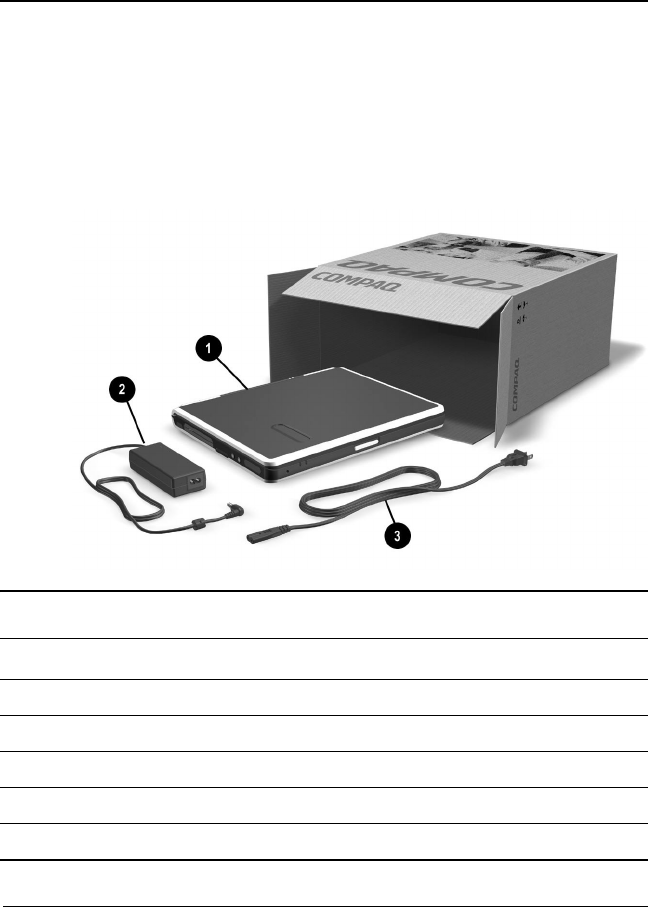
DRAFT - Revised:10-28-02
Hardware Guide 1–1
Compaq CONFIDENTIAL—For Internal Use Only
11/13/02
File: SP-CH1-Notebook Features.fm
1
Notebook Features
Contents of the Packing Box
Contents of the Packing Box
Item Component Description
This is place-holder
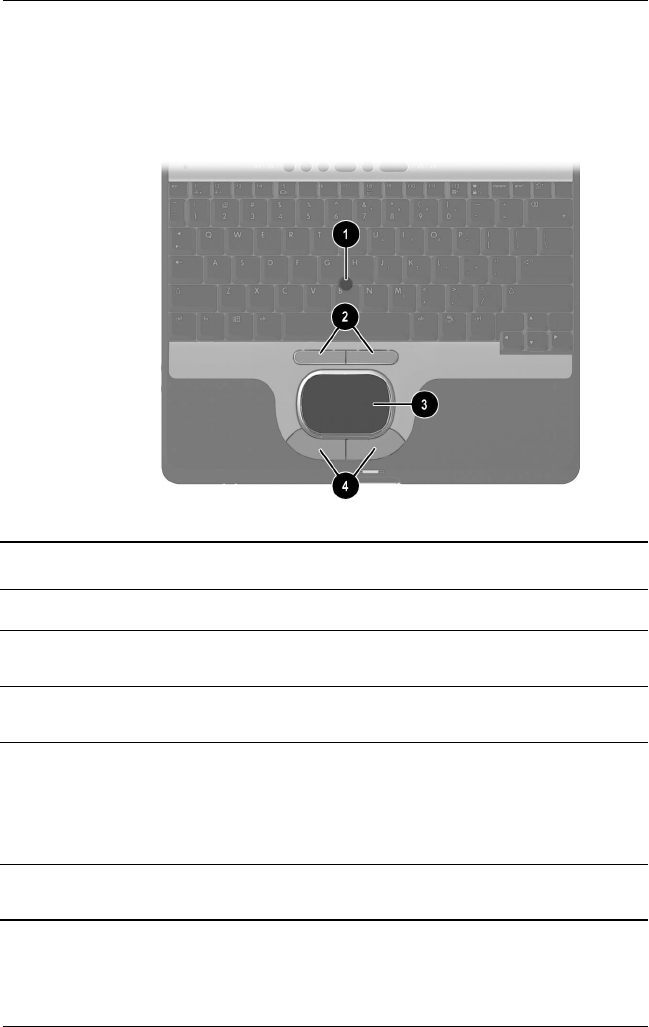
1–2 Hardware Guide
Notebook Features
DRAFT - Revised:10-28-02
Compaq CONFIDENTIAL—For Internal Use Only
11/13/02
File: SP-CH1-Notebook Features.fm
Notebook Features
Pointing Device Components
Pointing Device Components
Item Component Description
1Pointing stick Moves the pointer and selects or
activates items on the screen.
2Left and right TouchPad
buttons
Function like the left and right buttons
on an external mouse.
3TouchPad Moves the pointer and selects or
activates items on the screen. Can be
set to perform other mouse functions,
such as scrolling, selecting, and
double-clicking.
4Left and right pointing stick
buttons
Function like the left and right buttons
on an external mouse.
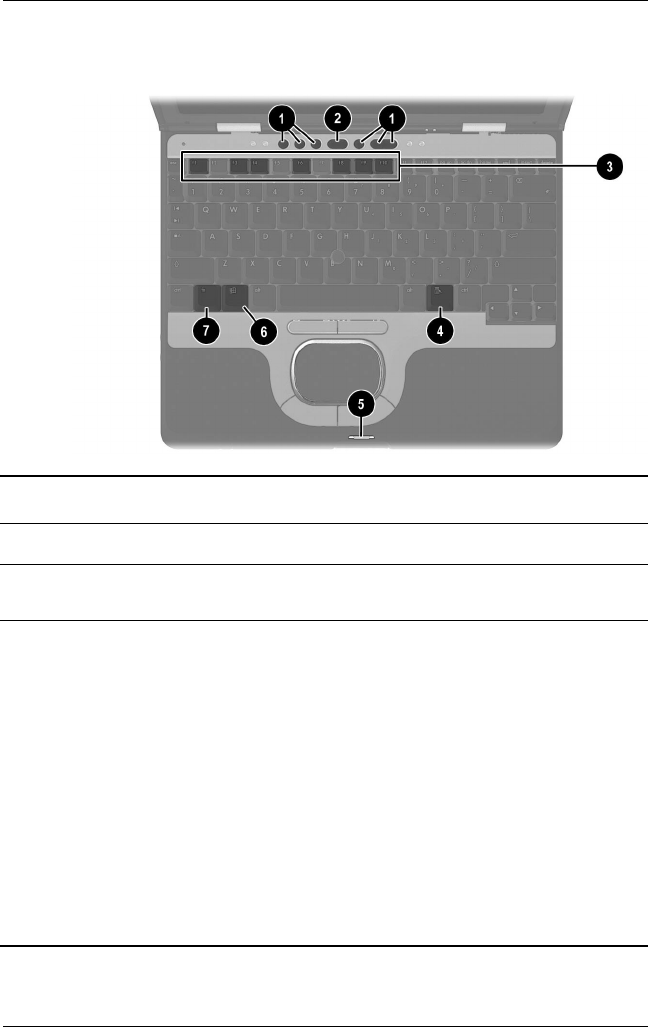
Notebook Features
Hardware Guide 1–3
DRAFT - Revised:10-28-02
Compaq CONFIDENTIAL—For Internal Use Only
11/13/02
File: SP-CH1-Notebook Features.fm
Top Components
Top Components
Item Component Description
1Quick Launch buttons (6) Enable you to access common
functions with a single keystroke.
2Power/standby button When the notebook is*:
■Off, press and release to turn on
the notebook.
■On, press and release to initiate
Standby.
■In Standby, press and release to
exit Standby.
■In Hibernation, press and release
to exit Hibernation.
If the system has stopped responding
and Windows shut down procedures
cannot be used, press and hold for 5
seconds to turn off the notebook.

1–4 Hardware Guide
Notebook Features
DRAFT - Revised:10-28-02
Compaq CONFIDENTIAL—For Internal Use Only
11/13/02
File: SP-CH1-Notebook Features.fm
3Function keys Execute frequently used system
functions when pressed in
combination with the Fn key.
4Applications key Displays shortcut menu for items
beneath the pointer.
5Display release latch
recess
Secures the display when it is closed.
6Microsoft logo key Displays the Windows Start menu.
7Fn key Executes frequently used system
functions when pressed in
combination with another key.
Not
shown
Primary memory
compartment (not shown,
located under the
keyboard)
Contains the primary memory slot.
* This table describes default settings. For information about changing the
functions of the power button and about using Standby and Hibernation, refer
on this CD to the Software Guide, “Power” chapter.
Top Components (Continued)
Item Component Description
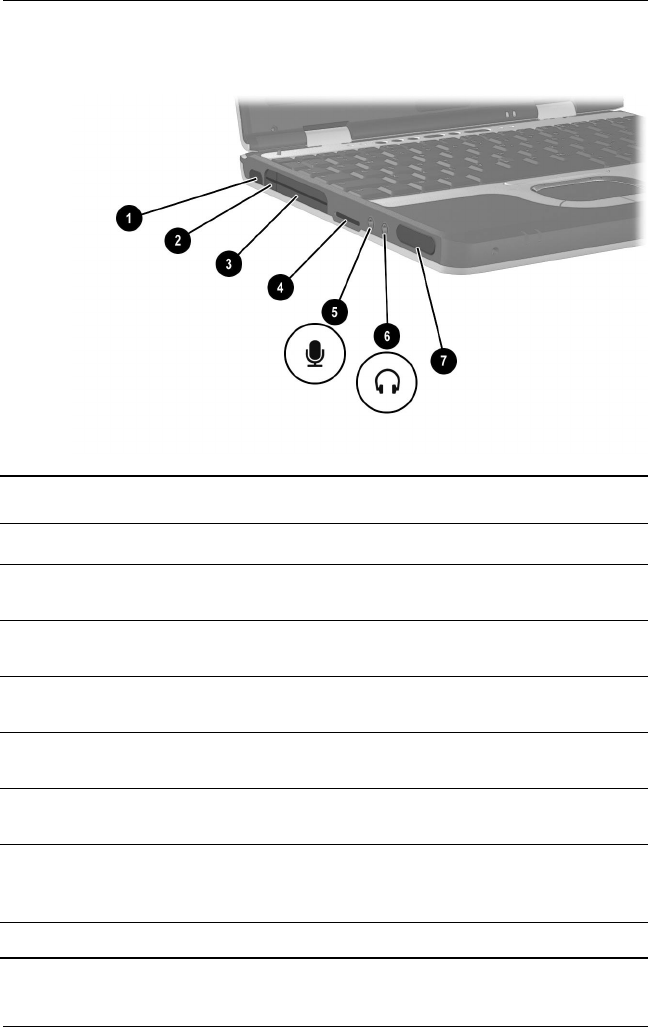
Notebook Features
Hardware Guide 1–5
DRAFT - Revised:10-28-02
Compaq CONFIDENTIAL—For Internal Use Only
11/13/02
File: SP-CH1-Notebook Features.fm
Left Side Components
Left Side Components
Item Component Description
1Infrared port Links another IrDA-compliant device
for wireless communication.
2PC Card eject button Ejects an optional PC Card from the
PC Card slot.
3PC Card slot Supports optional Type I or Type II
32-bit (CardBus) or 16-bit PC Cards.
4Secure Digital (SD) slot Accepts SD memory cards to increase
the memory capacity of the notebook.
5Audio line-in jack Connects an optional single-sound
channel microphone.
6Audio line-out jack Connects optional, powered stereo
speakers, headphones, headset, or
television audio.
7Speaker Produces stereo sound.
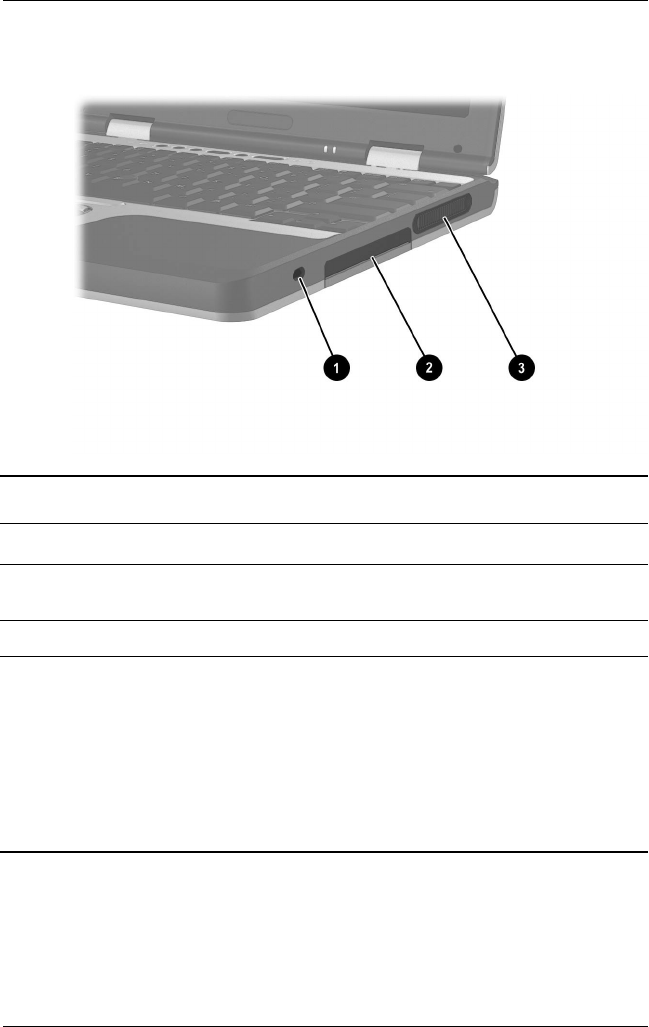
1–6 Hardware Guide
Notebook Features
DRAFT - Revised:10-28-02
Compaq CONFIDENTIAL—For Internal Use Only
11/13/02
File: SP-CH1-Notebook Features.fm
Right Side Components
Right Side Components
Item Component Description
1Security cable slot Attaches an optional security cable to
the notebook.
2Hard drive bay Holds the primary hard drive.
3Exhaust vent Enables airflow to cool internal
components.
ÄTo prevent overheating, do not
obstruct vents. Using the
notebook on a soft surface,
such as a pillow, blanket, rug,
or thick clothing may block
airflow.
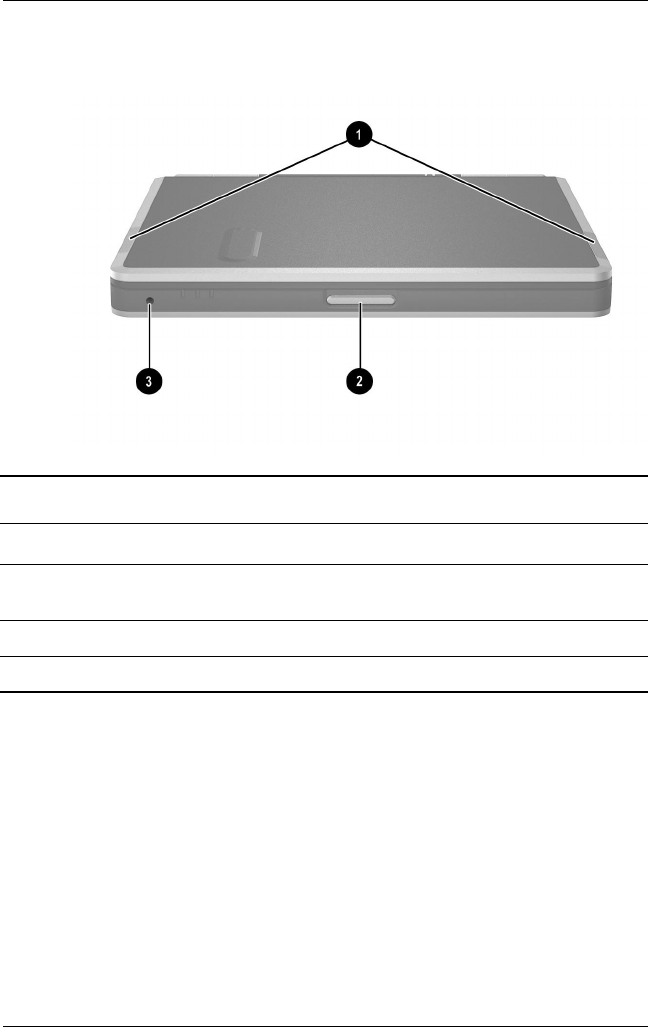
Notebook Features
Hardware Guide 1–7
DRAFT - Revised:10-28-02
Compaq CONFIDENTIAL—For Internal Use Only
11/13/02
File: SP-CH1-Notebook Features.fm
Front View Components
Front View Components
Item Component Description
1Antenna (2) Send and receive internal wireless
Local Area Network (LAN) signals.
2Microphone Inputs single-channel sound.
3Display release latch Opens the notebook.
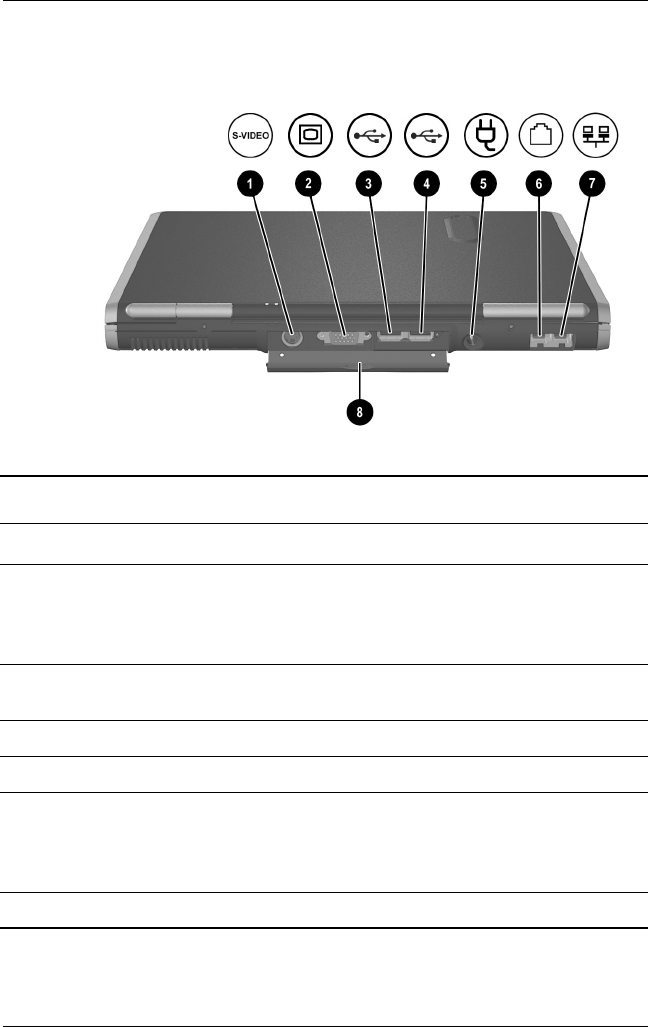
1–8 Hardware Guide
Notebook Features
DRAFT - Revised:10-28-02
Compaq CONFIDENTIAL—For Internal Use Only
11/13/02
File: SP-CH1-Notebook Features.fm
Rear Panel Components
Rear Panel Components
Item Component Description
1S-video out jack Connects an optional S-video device,
such as a television, VCR, camcorder,
overhead projector, or video capture
card.
2External monitor connector Connects an optional external monitor
or overhead projector.
3USB connector Connects USB devices.
4USB with power connector Connects powered USB devices.
5DC power connector Connects an AC Adapter or an
optional Automobile Power
Adapter/Charger, Aircraft Power
Adapter, or DC cable.
6RJ-45 jack Connects a network cable.
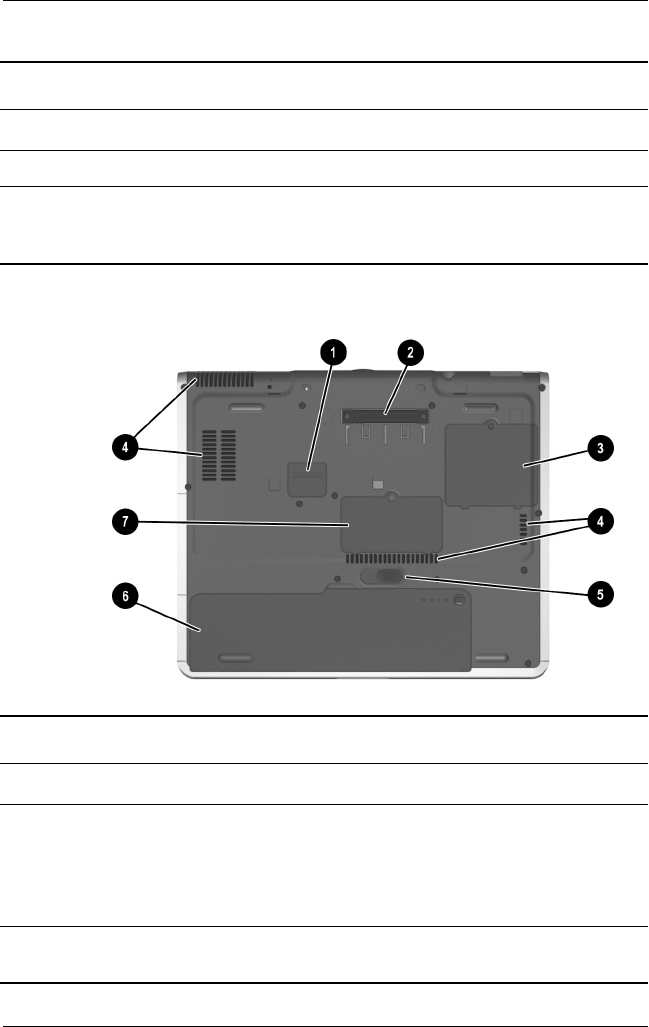
Notebook Features
Hardware Guide 1–9
DRAFT - Revised:10-28-02
Compaq CONFIDENTIAL—For Internal Use Only
11/13/02
File: SP-CH1-Notebook Features.fm
Bottom Components
7RJ-11 jack Connects a modem cable.
8Rear panel connector cover Closes to cover the connectors. This
cover can be removed by removing the
screws that secure it to the notebook.
Rear Panel Components (Continued)
Item Component Description
Bottom Components
Item Component Description
1Travel battery connector Connects the optional travel battery
bay. The travel battery connector has a
plastic cover that must be opened
before connecting the travel battery
bay.
2Docking connector Connects the notebook to an optional
Port Replicator.
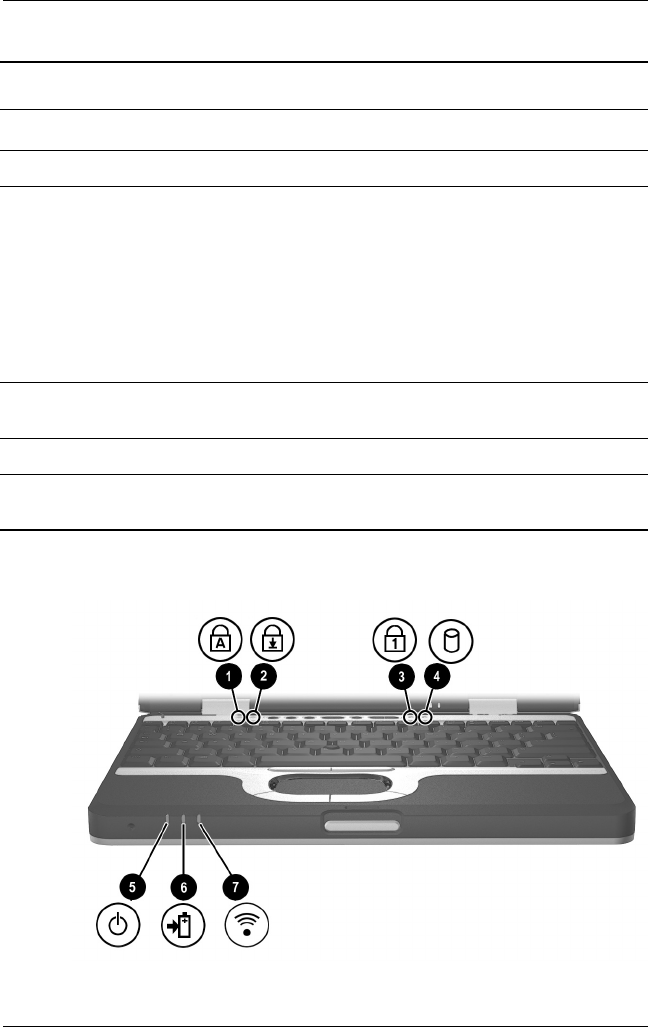
1–10 Hardware Guide
Notebook Features
DRAFT - Revised:10-28-02
Compaq CONFIDENTIAL—For Internal Use Only
11/13/02
File: SP-CH1-Notebook Features.fm
Lights
3Mini PCI compartment Contains the mini PCI wireless card.
4Intake vents Enables airflow to cool internal
components.
ÄTo prevent overheating, do not
obstruct vents. Using the
notebook on a soft surface,
such as a pillow, blanket, rug,
or thick clothing may block
airflow.
5Battery release latch Releases the primary battery pack
from the battery bay.
6Battery bay Holds the primary battery pack.
7Memory expansion
compartment
Contains 1 memory expansion slot for
optional memory expansion boards.
Bottom Components (Continued)
Item Component Description

Notebook Features
Hardware Guide 1–11
DRAFT - Revised:10-28-02
Compaq CONFIDENTIAL—For Internal Use Only
11/13/02
File: SP-CH1-Notebook Features.fm
Lights
Item Component Description
1Caps lock On: Caps lock is on.
2Scroll lock On: Scroll lock is on.
3Num lock On: Num lock is on or the embedded
numeric keypad is enabled.
4Hard drive activity On: The hard drive is being accessed.
5Power/standby On: Power is turned on.
Blinking: Notebook is in Standby.
✎The power/standby light also
blinks when a battery pack,
which is the only available
power source, reaches a
critical low-battery condition
while Hibernation is disabled.
6Battery On: A battery pack is charging.
Blinking: A battery pack, which is the
only available power source, has
reached a low-battery condition.
7Wireless on/off On: The notebook is connected to a
wireless LAN.
Blinking: Information is being
transmitted.
Off: The notebook is not connected to
a wireless LAN.
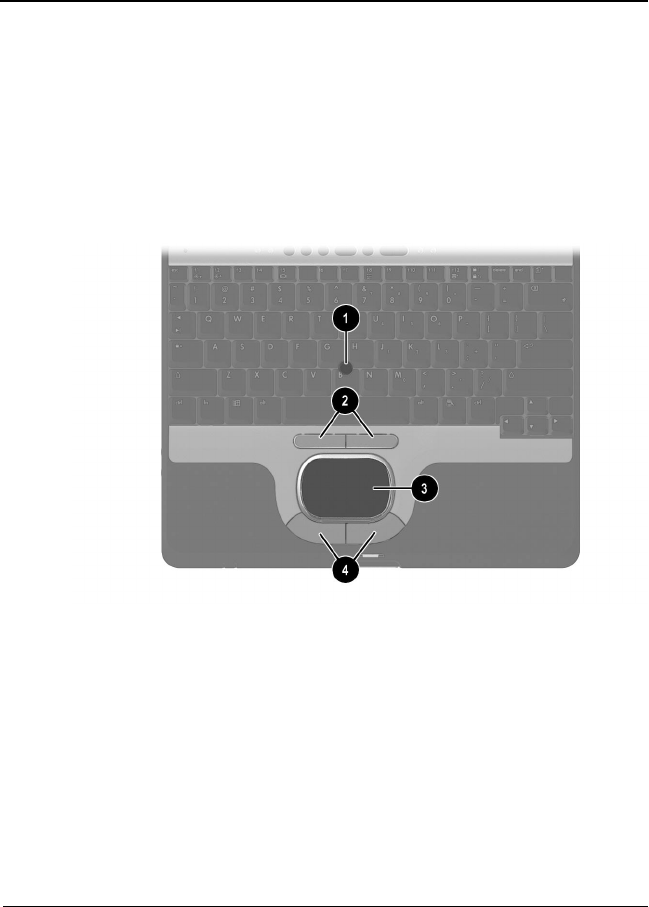
DRAFT - Revised: 10-28-02
Hardware Guide 2–1
Compaq CONFIDENTIAL—For Internal Use Only
11/13/02
File: SP-CH2-Keyboard.fm
2
Pointing Devices and Keyboard
Using a Pointing Device
By default, the pointing stick and TouchPad components can be
used interchangeably.
Pointing device components

2–2 Hardware Guide
Pointing Devices and Keyboard
DRAFT - Revised: 10-28-02
Compaq CONFIDENTIAL—For Internal Use Only
11/13/02
File: SP-CH2-Keyboard.fm
Using the Pointing Stick
To move the pointer, press the pointing stick in the direction
you want to move the pointer. Use the left and right pointing stick
buttons as you would the left and right buttons on an external
mouse.
To change the pointing stick cap:
1. Turn off the notebook.
2. Gently pull off the used pointing stick cap.
3. Push a replacement cap, included with the notebook,
into place.
Pointing Device Components
Item Component Description
1Pointing stick Moves the pointer and selects or
activates items on the screen.
2Left and right pointing
stick button
Functions like the left and right
buttons on an external mouse.
3TouchPad Moves the pointer and selects or
activates items on the screen. Can
be set to perform other mouse
functions, such as scrolling,
selecting, and double-clicking.
4Left and right TouchPad
buttons
Functions like the left and right
buttons on an external mouse.
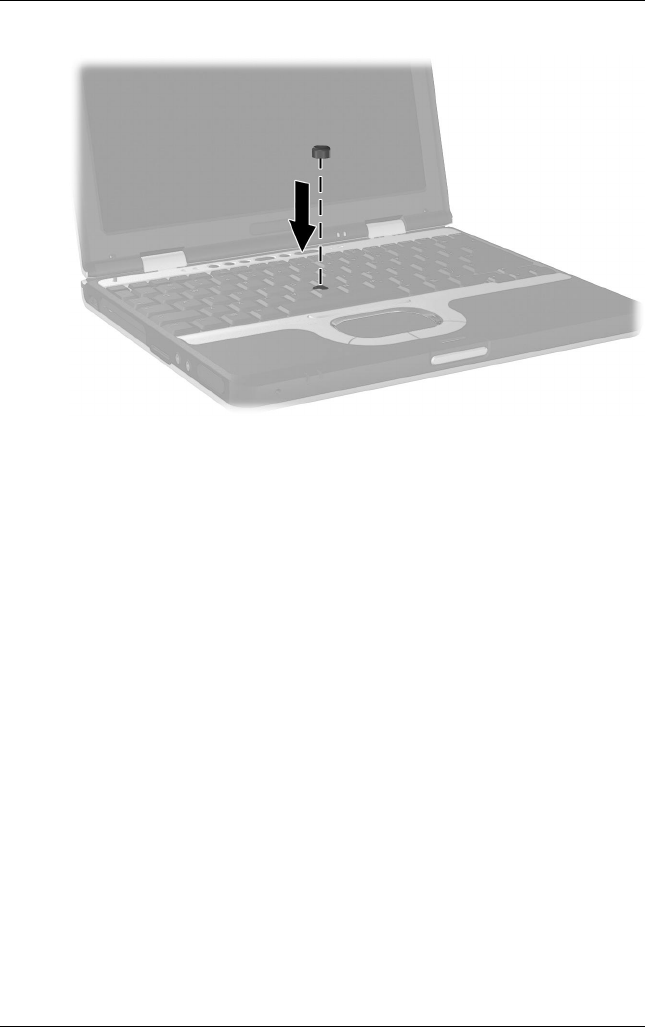
Pointing Devices and Keyboard
Hardware Guide 2–3
DRAFT - Revised: 10-28-02
Compaq CONFIDENTIAL—For Internal Use Only
11/13/02
File: SP-CH2-Keyboard.fm
Replacing the pointing stick cap
Using the TouchPad
To move the pointer, slide your finger across the TouchPad
surface in the direction you want to move the pointer. Use the
left and right TouchPad buttons as you would the left and right
buttons on an external mouse.
Using an External Mouse
An external USB mouse can be connected to the notebook using
one of the USB connectors on the back panel. An external PS/2 or
USB mouse can be connected to the system using the connectors
on an optional Port Replicator.

2–4 Hardware Guide
Pointing Devices and Keyboard
DRAFT - Revised: 10-28-02
Compaq CONFIDENTIAL—For Internal Use Only
11/13/02
File: SP-CH2-Keyboard.fm
Setting Pointing Device Preferences
Mouse Properties in Windows enables you to change custom
settings for pointing devices, including:
■Enabling or disabling a pointing device.
■TouchPad tapping, which enables you to tap the TouchPad
once to select an object or twice to double-click an object.
■Edge motion, which enables you to continue to scroll even
though your finger has reached the edge of the TouchPad.
■Palm Check, which helps prevent moving the pointer
unintentionally if your palms contact the TouchPad as you
type.
Other features, such as mouse speed preferences and mouse trails,
are also found in the Mouse Properties windows.
To access Mouse Properties:
■In Windows 2000 Professional, select Start > Settings >
control Panel > Mouse icon.
■In Windows XP Professional, select Start > Control Panel >
printers and Other Hardware > mouse icon.
■In Windows XP Home, select Start > Control Panel >
printers and Other Hardware > mouse icon.
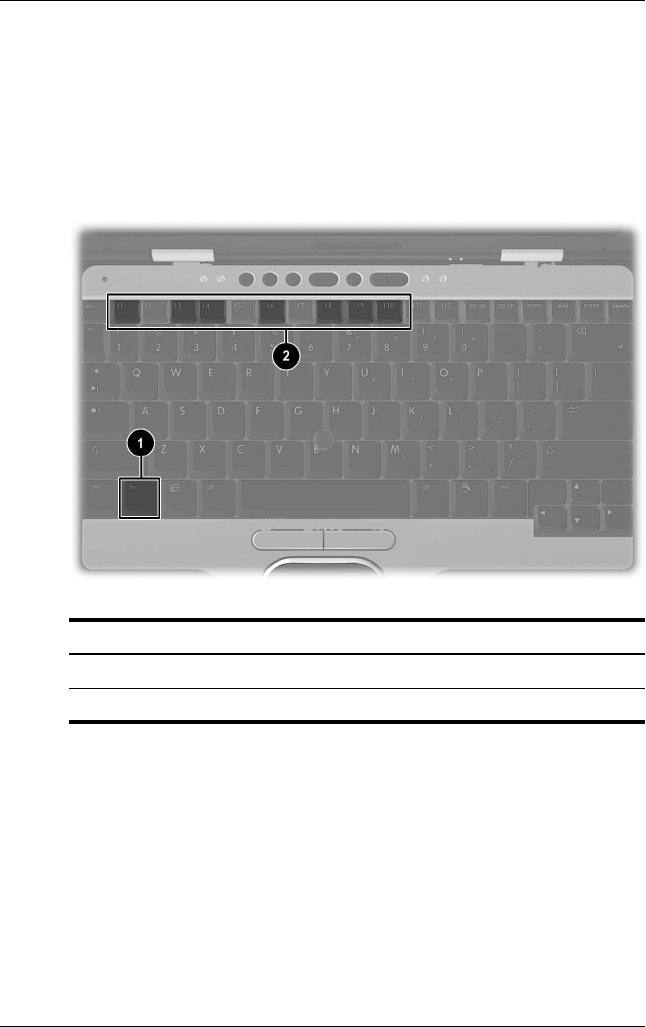
Pointing Devices and Keyboard
Hardware Guide 2–5
DRAFT - Revised: 10-28-02
Compaq CONFIDENTIAL—For Internal Use Only
11/13/02
File: SP-CH2-Keyboard.fm
Using Hotkeys and Shortcut Keys
Hotkeys and shortcut keys, which are preset combinations of the
Fn key and another key, execute frequently used system functions.
Fn and Function Keys
Fn and function keys
■A hotkey is a combination of the Fn key and one of the
function keys. The icons on the function keys represent the
hotkey functions available on your notebook.
■A shortcut key is a combination of the Fn key and a key other
than a function key.
Item Component
1Fn key
2Function keys

2–6 Hardware Guide
Pointing Devices and Keyboard
DRAFT - Revised: 10-28-02
Compaq CONFIDENTIAL—For Internal Use Only
11/13/02
File: SP-CH2-Keyboard.fm
Hotkey and Shortcut Key Quick Reference
Display Help (Fn+F1)
The Fn+F1 hotkeys display help and support information. For
more information on help and support, refer to the Worldwide
Telephone Numbers booklet.
Function
Key Combination to
Activate Function
Key Combination to
Deactivate Function
Display help Fn+F1 Fn+F1
Initiate Standby Fn+F3 Power/standby button
Switch display and
image
Fn+F4 Fn+F4
Initiate Quick Controls Fn+F6 Enter Power-on
password
View battery charge
information
Fn+F8 Fn+F8
Adjust the screen
brightness to a lower
level
Fn+F9 N/A
Adjust the screen
brightness to a higher
level
Fn+F10 N/A
Display system
information
Fn+esc Fn+esc

Pointing Devices and Keyboard
Hardware Guide 2–7
DRAFT - Revised: 10-28-02
Compaq CONFIDENTIAL—For Internal Use Only
11/13/02
File: SP-CH2-Keyboard.fm
Initiate Standby (Fn+F3)
The Fn+F3 hotkeys are set at the factory to initiate Standby.
■When the notebook is on, press the Fn+F3 hotkeys to initiate
Standby. When Standby is initiated, your work is saved in
random access memory (RAM), the screen is cleared, and
power is conserved. While the notebook is in Standby, the
power/standby light blinks.
■To exit Standby, briefly press the power/standby button.
The function of the Fn+F3 hotkeys, called the “sleep button” in
Windows, can be changed. For example, the Fn+F3 hotkeys can be
set to initiate Hibernation instead of Standby. For more
information about Standby, Hibernation, and changing the
function of the Fn+F3 hotkeys, refer on this CD to the Software
Guide, “Power” section.
Switching Display and Image (Fn+F4)
The Fn+F4 hotkeys switch the image between the display and an
external display device connected to the notebook. Pressing Fn+F4
switches the image among the notebook display, the external
display device, and a simultaneous display on the notebook and
the external device.
The following video transmission types are supported by the
Fn+F4 hotkeys:
■LCD (notebook display)
■External VGA (most external monitors and projectors)
■S-video (televisions, camcorders, VCRs, and video capture
cards with S-video-in jacks)

2–8 Hardware Guide
Pointing Devices and Keyboard
DRAFT - Revised: 10-28-02
Compaq CONFIDENTIAL—For Internal Use Only
11/13/02
File: SP-CH2-Keyboard.fm
Initiating Quick Controls (Fn+F6)
Quick Control security features disable the keyboard and pointing
device and clear the display.
Before you can use the Quick Controls, you must set a power-on
password and select Quick Control preferences. For more
information, refer on this CD to the Software Guide, “Security”
chapter.
To initiate Quick Controls manually, press Fn+F6. To exit Quick
Controls, enter your Windows password.
Viewing Battery Charge Information (Fn+F8)
Press Fn+F8 to display charge information for all installed battery
packs. The display indicates which battery packs are charging and
reports the amount of charge remaining in each battery pack.
Battery pack locations are indicated by number:
■Location 1 is the primary battery pack.
■Location 2 is the travel battery pack.
Adjusting the Screen Brightness (Fn+F9 and
Fn+F10)
Pressing the Fn+F9 and the Fn+F10 hotkeys respectively increases
and decreases the display brightness among several levels of
brightness. Press Fn+F9 to lower the brightness level, and press
Fn+F10 to increase the brightness level. Holding down the hotkeys
changes the brightness level incrementally.
Displaying System Information (Fn+Esc)
Press Fn+esc to display information about system hardware
components and software version numbers. Press Fn+esc a second
time to remove the system information from the screen.

Pointing Devices and Keyboard
Hardware Guide 2–9
DRAFT - Revised: 10-28-02
Compaq CONFIDENTIAL—For Internal Use Only
11/13/02
File: SP-CH2-Keyboard.fm
✎The system BIOS date is the version number of the system ROM.
The BIOS date may display in a decimal format, for example,
10/19/2002 A.07.
Using Hotkeys and Shortcut Keys with External
Keyboards
The following hotkeys and shortcut keys can be used as described
with external keyboards:
■Fn+esc
■Fn+F8
■Fn+F6
To use hotkeys or shortcut keys on an external keyboard, press the
scroll lock key twice, then the other key of the hotkey
combination. For example, to use the Fn+F8 hotkeys, press scroll
lock+scroll lock+F8.
Hotkeys and shortcut keys may not function on an external
keyboard connected through a USB connector if Quick Launch
Buttons software is not loaded. You can download the appropriate
software and drivers for your system at www.hp.com. For more
information on software updates, refer on this CD to the Software
Guide, “Software Updates and Restorations” chapter. For more
information about Quick Launch buttons, refer to “Using Quick
Launch Buttons” later in this chapter.
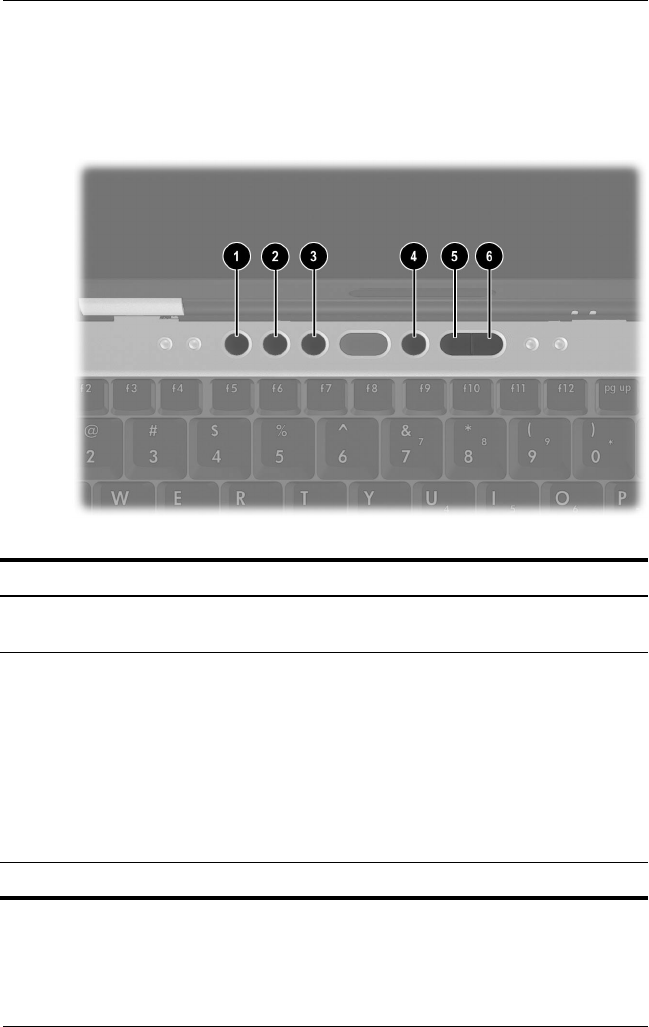
2–10 Hardware Guide
Pointing Devices and Keyboard
DRAFT - Revised: 10-28-02
Compaq CONFIDENTIAL—For Internal Use Only
11/13/02
File: SP-CH2-Keyboard.fm
Using Quick Launch Buttons
The 6 Quick Launch buttons enable you to access common
functions with a single keystroke.
Quick Launch buttons
Item Component Description
1Wireless On/Off button Turns the wireless Local Area Network
(LAN) on and off.
2Presentation Mode
button
Sets the notebook to presentation
mode, which opens a user-defined
application, folder, file, or Web site.
The image simultaneously displays on
the notebook screen and an external
device connected to they external
monitor connector or S-video-out jack
on the rear panel or to connectors on
an optional Port Replicator.
3Internet button Launches Internet Explorer.

Pointing Devices and Keyboard
Hardware Guide 2–11
DRAFT - Revised: 10-28-02
Compaq CONFIDENTIAL—For Internal Use Only
11/13/02
File: SP-CH2-Keyboard.fm
Keypads
The notebook has an internal numeric keypad and supports an
optional external numeric keypad or an optional external
keyboard that includes a numeric keypad.
Using the Internal Keypad
The 15 keys of the embedded numeric keypad can be used like
the keys on an external keypad. When the internal keypad is
turned on, each key on the internal keypad performs the functions
indicated by the icon in the upper right corner of the key.
4Mute button Mutes and restores the system
volume.
5Volume - button Decreases the system volume level.
To mute or restore volume, press both
volume buttons at the same time.
6Volume + button Increases the system volume level. To
mute or restore volume, press both
volume buttons at the same time.
Item Component Description
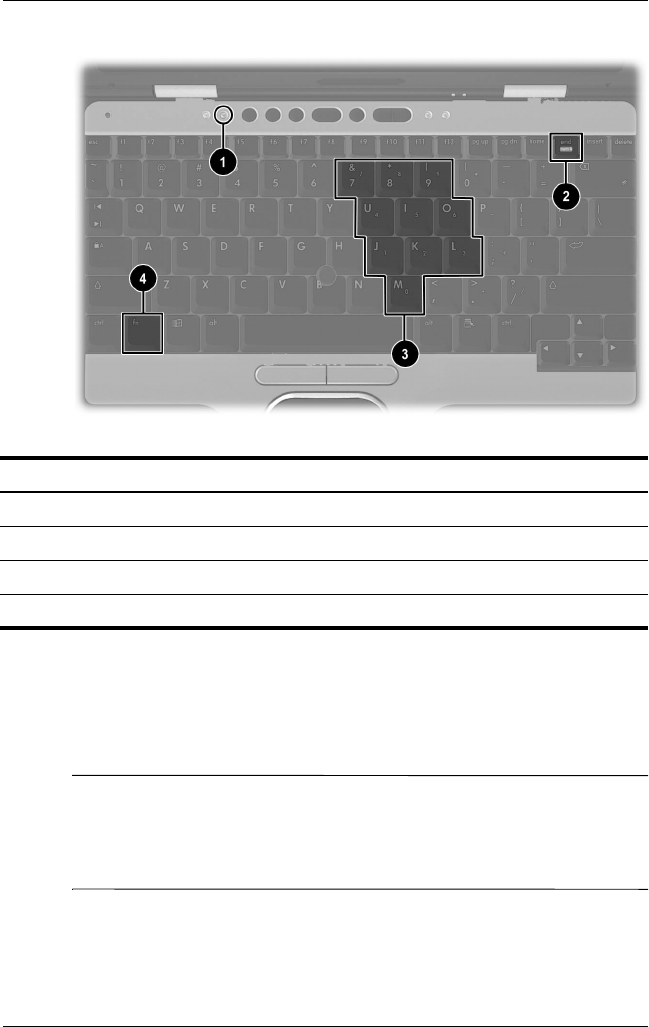
2–12 Hardware Guide
Pointing Devices and Keyboard
DRAFT - Revised: 10-28-02
Compaq CONFIDENTIAL—For Internal Use Only
11/13/02
File: SP-CH2-Keyboard.fm
Embedded numeric keypad components
Enabling and Disabling the Internal Keypad
Press Fn+num lk to enable the embedded numeric keypad. The
num lock light turns on. Press Fn+num lk again to return the keys
to their standard keyboard functions.
✎The numeric keypad cannot be enabled while an optional external
keypad is connected an optional Port Replicator or if an optional
external keyboard is attached to the notebook or an optional Port
Replicator.
Item Component
1num lock light
2num lock key
3Numeric keypad keys
4Fn key

Pointing Devices and Keyboard
Hardware Guide 2–13
DRAFT - Revised: 10-28-02
Compaq CONFIDENTIAL—For Internal Use Only
11/13/02
File: SP-CH2-Keyboard.fm
Switching Key Functions on the Internal Keypad
You can temporarily switch the functions of keys on the internal
keypad between their standard keyboard functions and their
keypad functions by using the Fn key or the Fn+shift key
combination.
■To change the functions of a keypad key to keypad functions
while the keypad is off, press and hold the Fn key while
pressing the keypad key.
■To use the keypad keys temporarily as standard keys while
the keypad is on:
❏Press and hold the Fn key to type in lowercase.
❏Press and hold Fn+shift to type in uppercase.
Using an External Keypad
Most keys on most external keypads function differently when
num lock mode is on than when num lock mode is off. For
example:
■When num lock mode is on, most keypad keys type numbers.
■When num lock mode is off, most keypad keys function like
arrow, page up, or page down keys.
When num lock mode on an external keypad is turned on, the
num lock light on the notebook turns on. When the num lock
mode on external keypad is turned off, the num lock light on the
notebook turns off.
If the external keypad is connected, the internal keypad cannot be
turned on.
Enabling or Disabling Num Lock Mode as You Work
To turn num lock on or off on an external keypad as you work,
press the num lk key on the external keypad, not on the notebook.

2–14 Hardware Guide
Pointing Devices and Keyboard
DRAFT - Revised: 10-28-02
Compaq CONFIDENTIAL—For Internal Use Only
11/13/02
File: SP-CH2-Keyboard.fm
Enabling or Disabling the Numeric Keypad at Startup
To set the notebook to startup with a connected external keypad in
num lock mode, set your preference in Computer Setup. For more
information about using Computer Setup, refer on this CD to the
Software Guide, “Setup and Diagnostic Utilities” section.
To set the notebook to start up with the external keypad enabled:
1. Turn on or restart the notebook.
2. Press F10 while the F10 = ROM Based Setup message is
displayed in the lower left corner of the screen.
❏To change the language, press F2.
❏For navigation instructions, press F1.
3. Select Advanced > Device Options, then press enter.
4. Select or clear the Num Lock State at Boot field:
❏To start up an external keypad with num lock mode
turned on, select the field.
❏To start up an external keypad with num lock mode
turned off, clear the field.
5. Press F10.
6. To save your preference and exit Computer Setup, select
File > Save Changes and Exit, then follow the instructions on
the screen.
Your preference is set as you exit Computer Setup and is in effect
when the notebook restarts.
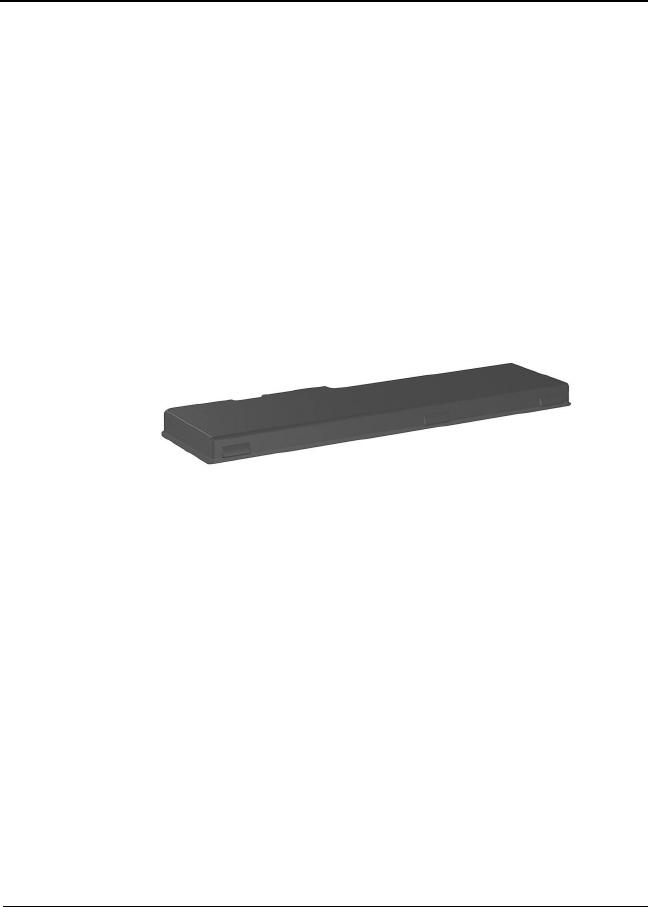
DRAFT - Revised: 10/28/02
Hardware Guide 3–1
Compaq CONFIDENTIAL—For Internal Use Only
11/13/02
File: SP-CH3-Battery.fm
3
Battery Packs
This notebook supports up to 2 lithium ion battery packs. The
same type of battery pack can be used in the notebook battery bay
and the optional travel battery.
Battery pack
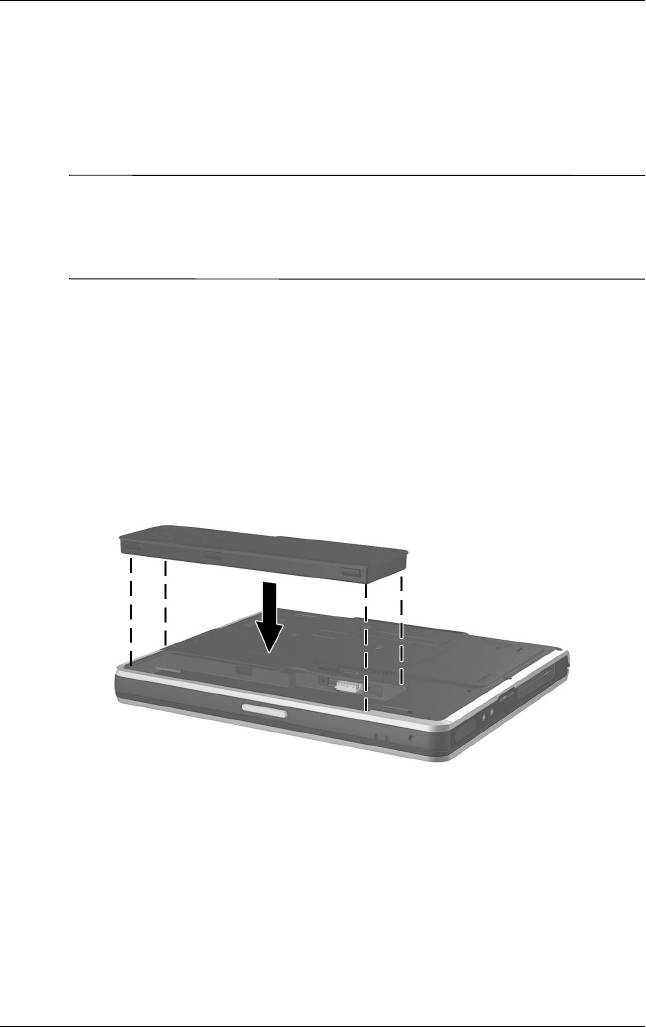
3–2 Hardware Guide
Battery Packs
DRAFT - Revised: 10/28/02
Compaq CONFIDENTIAL—For Internal Use Only
11/13/02
File: SP-CH3-Battery.fm
Inserting or Removing the Primary
Battery Pack
The notebook battery bay holds the primary battery pack.
ÄCAUTION: To prevent the loss of information when removing a
battery pack, when it is the only power source available to the
system, initiate Hibernation or shut down the notebook before
removing the battery pack.
To insert the primary battery pack:
1. Align the battery pack with the notebook battery bay.
2. Snap the battery pack into place.
Inserting the primary battery pack
3. Turn the notebook over and open the display. If the notebook
is in Hibernation, press the power/standby button to resume
operation.
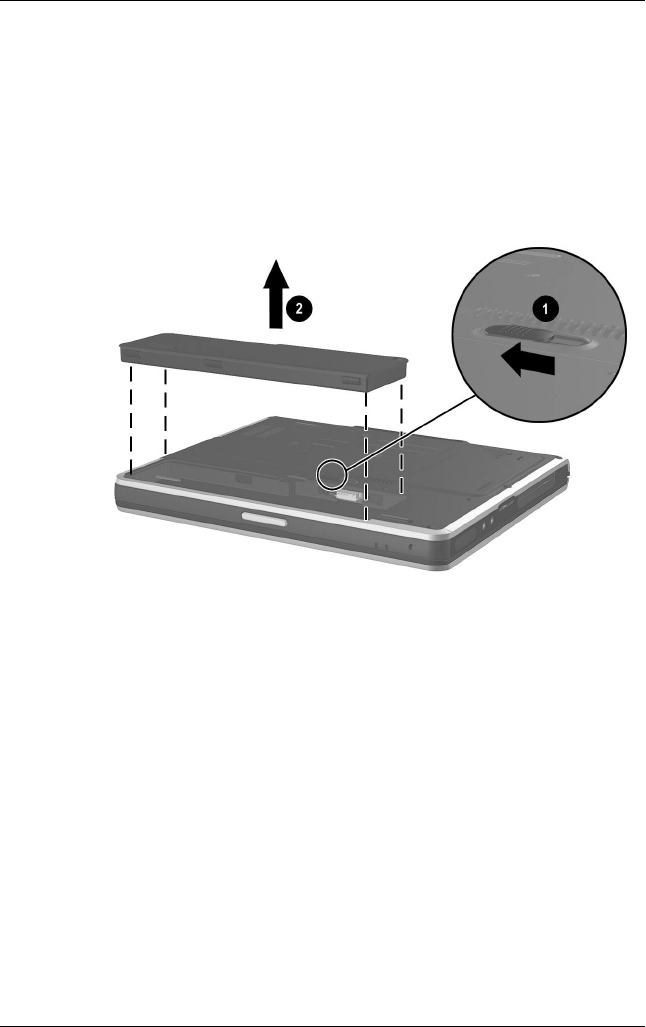
Battery Packs
Hardware Guide 3–3
DRAFT - Revised: 10/28/02
Compaq CONFIDENTIAL—For Internal Use Only
11/13/02
File: SP-CH3-Battery.fm
To remove the primary battery pack:
1. Close the display and turn the notebook bottom-side up.
2. Slide the battery release latch 1.
3. After the battery pack tilts upward, remove it from the battery
bay 2.
Removing the primary battery pack
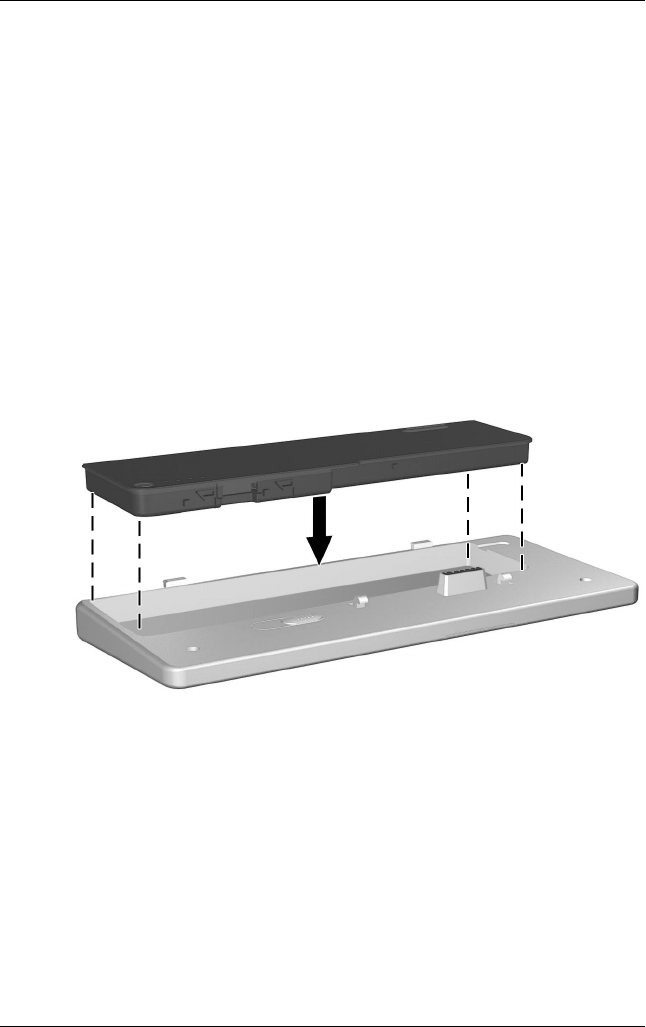
3–4 Hardware Guide
Battery Packs
DRAFT - Revised: 10/28/02
Compaq CONFIDENTIAL—For Internal Use Only
11/13/02
File: SP-CH3-Battery.fm
Using the Optional Travel Battery
The optional travel battery holds the second battery pack and
attaches to the bottom of the notebook with the travel battery
connector.
Inserting or Removing the Battery Pack
To insert the battery pack into the travel battery:
1. Align the battery pack with the travel battery.
2. Snap the battery pack into place.
Inserting the battery pack into the travel battery
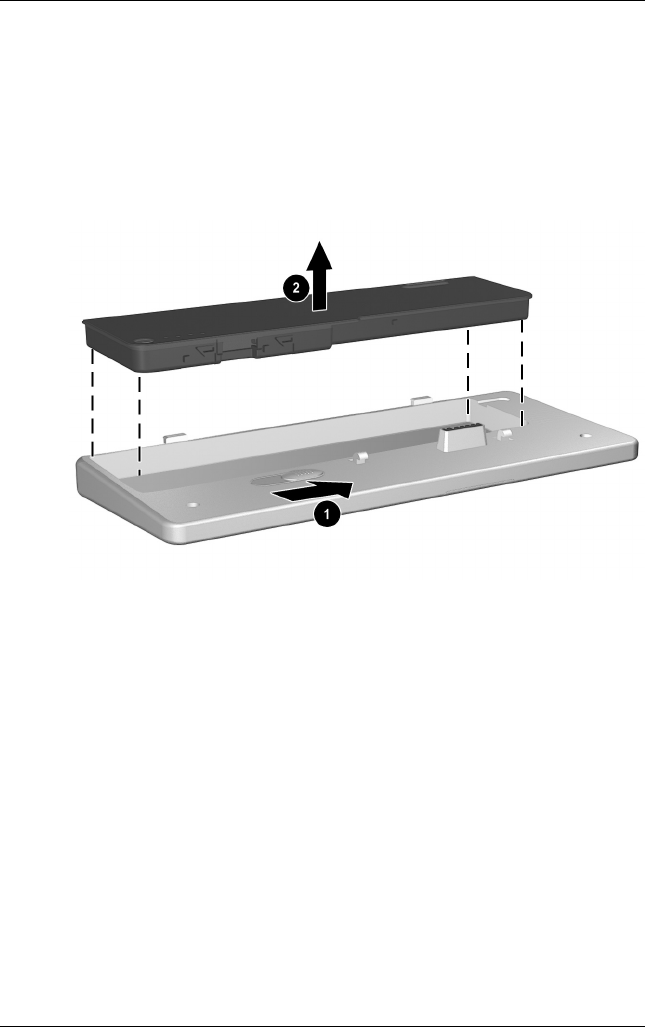
Battery Packs
Hardware Guide 3–5
DRAFT - Revised: 10/28/02
Compaq CONFIDENTIAL—For Internal Use Only
11/13/02
File: SP-CH3-Battery.fm
To remove the battery pack from the travel battery:
1. Eject the battery pack from the travel battery by sliding the
battery release latch 1.
2. When the battery pack tilts upward, remove it from the travel
battery 2.
Removing a battery pack from the travel battery

3–6 Hardware Guide
Battery Packs
DRAFT - Revised: 10/28/02
Compaq CONFIDENTIAL—For Internal Use Only
11/13/02
File: SP-CH3-Battery.fm
Attaching or Detaching the Travel Battery and
the Notebook
To attach the optional travel battery:
1. Open the travel battery connector on the bottom of the
notebook by sliding the cover.
Opening the travel battery connector
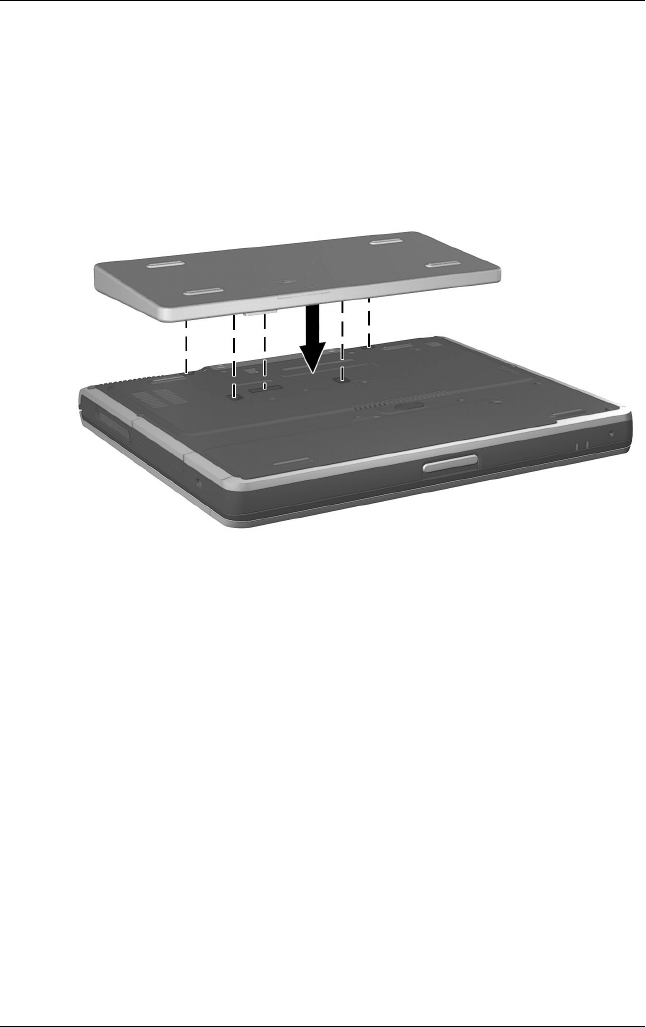
Battery Packs
Hardware Guide 3–7
DRAFT - Revised: 10/28/02
Compaq CONFIDENTIAL—For Internal Use Only
11/13/02
File: SP-CH3-Battery.fm
2. Align the tabs on the travel battery with the recesses on the
bottom of the notebook.
3. Press the travel battery onto the notebook until it snaps into
place.
Attaching the travel battery
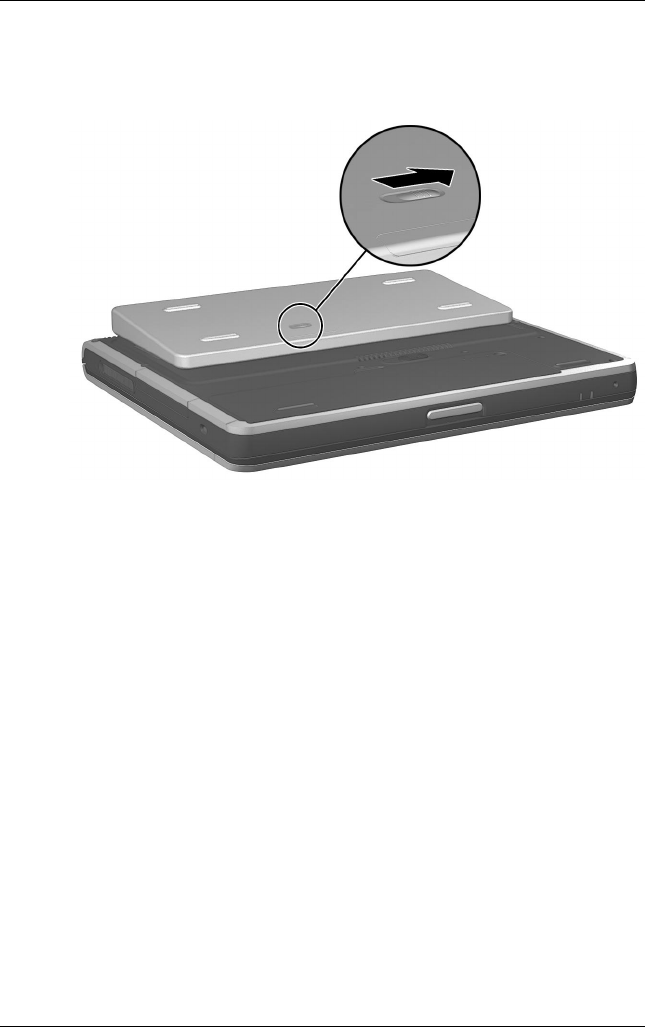
3–8 Hardware Guide
Battery Packs
DRAFT - Revised: 10/28/02
Compaq CONFIDENTIAL—For Internal Use Only
11/13/02
File: SP-CH3-Battery.fm
4. Lock the travel battery onto the notebook by sliding the
locking switch.
Locking the travel battery onto the notebook
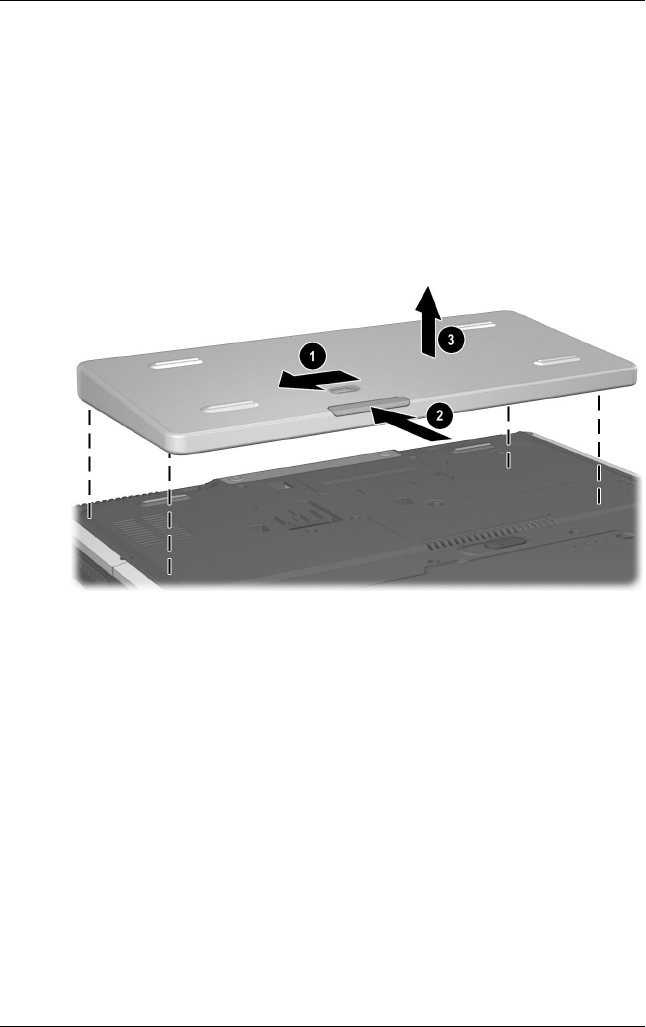
Battery Packs
Hardware Guide 3–9
DRAFT - Revised: 10/28/02
Compaq CONFIDENTIAL—For Internal Use Only
11/13/02
File: SP-CH3-Battery.fm
To detach the travel battery from the notebook:
1. Unlock the travel battery from the notebook by sliding the
locking switch 1.
2. Press the release latch 2.
3. Lift the travel battery up and away from the notebook 3.
Detaching the travel battery from the notebook
Charging a Battery Pack
Multiple battery packs in the system charge and discharge in a
preset sequence determined by location:
■Charge sequence:
1. Notebook battery bay
2. Travel battery
■Discharge sequence:
1. Travel battery
2. Notebook battery bay
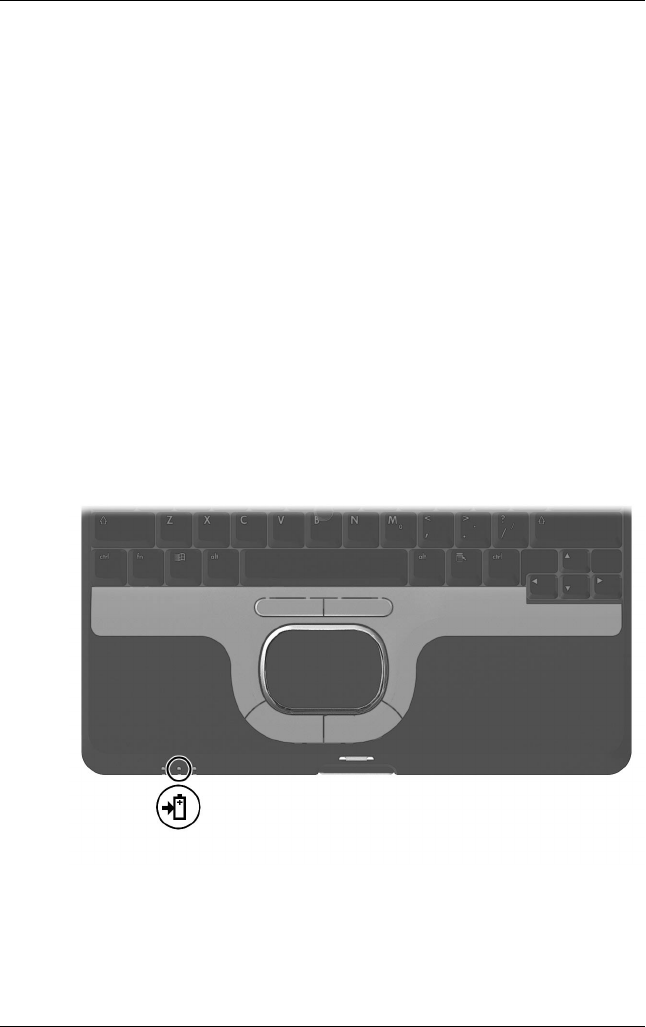
3–10 Hardware Guide
Battery Packs
DRAFT - Revised: 10/28/02
Compaq CONFIDENTIAL—For Internal Use Only
11/13/02
File: SP-CH3-Battery.fm
The primary battery pack charges when it is inserted into the
notebook and the notebook is connected to external power.
External power can be supplied through an AC Adapter, the
optional Advanced Port Replicator, or an optional Automobile
Power Adapter/Charger.
The battery pack in the travel battery charges when it is attached
to the notebook and the notebook is connected to external power.
External power can be supplied through an AC Adapter or an
optional Automobile Power Adapter/Charger. Because the travel
battery covers the docking connector, the travel battery can not be
used or charged with the advanced port replicator.
Battery packs can also be charged in the optional Universal
Charger. The optional Aircraft Power Adapter can be used to run
the notebook, but cannot be used to charge a battery pack.
While the battery pack is charging, the battery light on the
notebook is on. The light turns off when the battery pack is fully
charged.
Battery light

Battery Packs
Hardware Guide 3–11
DRAFT - Revised: 10/28/02
Compaq CONFIDENTIAL—For Internal Use Only
11/13/02
File: SP-CH3-Battery.fm
To charge the primary battery pack:
1. Insert the battery pack into the notebook.
2. Connect the notebook to AC power. (The battery light
turns on.)
3. Leave the notebook connected to AC power until the battery
light turns off, signaling that the battery pack is fully charged.
To charge the battery pack in the travel battery:
1. Insert the battery pack into the travel battery.
2. Attach the travel battery to the notebook.
3. Connect the notebook to AC power. (The battery light
turns on.)
4. Leave the notebook connected to AC power until the battery
light turns off, signaling that the battery pack is fully charged.
Monitoring the Charge of a Battery Pack
To increase the accuracy of all battery charge displays:
■Allow a battery pack to discharge to less than 10 percent of a
full charge through normal use before charging it.
■When you charge a battery pack, charge it fully.
■If a battery pack has not been used for one month or more,
calibrate the battery pack instead of simply charging it. For
calibration instructions, refer to “Calibrating a Battery Pack”
later in this chapter.

3–12 Hardware Guide
Battery Packs
DRAFT - Revised: 10/28/02
Compaq CONFIDENTIAL—For Internal Use Only
11/13/02
File: SP-CH3-Battery.fm
Displaying Charge Information on the Screen
To display battery charge information on the screen, use the
Power meter feature of the operating system:
■Select Start > Control Panel > Performance and Maintenance
icon > Power Options icon > Power Meter tab.
or
■Select the Power meter icon in the system tray.
To display the Power meter icon in the system tray:
1. Select Start > Control Panel > Performance and Maintenance
icon > Power Options icon > Advanced tab.
2. Select the Always Show Icon On The Taskbar check box.
3. Select the OK button.
Most charge displays report battery status in both percent and
time:
■The percent indicates the amount of charge remaining in the
battery pack.
■The time indicates the approximate running time remaining
on the battery pack if the battery pack continues to provide
power at the current level. For example, the time remaining
will decrease if you start playing a DVD and will increase if
you stop playing a DVD.
Most charge displays identify battery packs by location:
■Location 1 is the notebook battery bay.
■Location 2 is the travel battery.
In some displays, a lightening bolt icon may be displayed beside
a battery pack location. This icon indicates that the battery pack is
being charged.
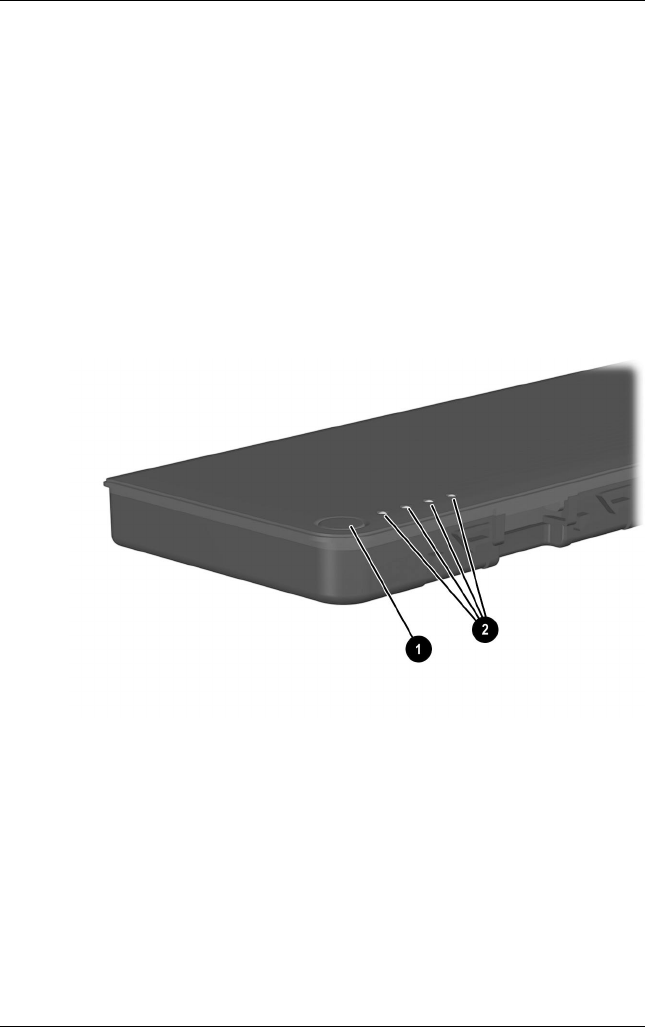
Battery Packs
Hardware Guide 3–13
DRAFT - Revised: 10/28/02
Compaq CONFIDENTIAL—For Internal Use Only
11/13/02
File: SP-CH3-Battery.fm
Displaying Charge Information on a Battery Pack
The battery Quick Check feature enables you to check the battery
pack charge information. You do not have to remove a battery
pack from the notebook battery bay or the travel battery to check
the charge information; however, you must detach the travel
battery from the notebook to check the charge of the travel bay
battery pack.
To display the percentage of a full charge remaining on a battery
pack, press the Quick Check button 1 on the battery pack. The
Quick Check lights 2 on the battery pack indicate the charge
remaining, as shown in the table below.
Battery pack Quick Check button and lights

3–14 Hardware Guide
Battery Packs
DRAFT - Revised: 10/28/02
Compaq CONFIDENTIAL—For Internal Use Only
11/13/02
File: SP-CH3-Battery.fm
Managing Low-Battery Conditions
Some low-battery condition alerts and system responses can be
changed in the Power Options Properties window of the operating
system. The information in this chapter describes the alerts and
system responses set at the factory. For information about setting
preferences in the Power Options Properties window, refer on this
CD to the Software Guide, “Power” chapter, “Setting Power
Preferences” section.
Identifying Low-Battery Conditions
The notebook has alerts for 2 types of low-battery conditions: a
low-battery condition and a critical low-battery condition.
Low-Battery Condition
When a battery pack that is the only power source available
reaches a low-battery condition (10 percent of a full charge), the
battery light flashes.
Critical Low-Battery Condition
If a low-battery condition is not resolved, the notebook enters a
critical low-battery condition (one percent of a full charge). In a
critical low-battery condition:
Battery Pack Quick Check Indications
Indication Percent of a Full Charge Remaining
4 lights on 76 to 100%
3 lights on 51 to75%
2 lights on 26 to 50%
1 light on 11 to 25%
1 light blinking 1 to 10%

Battery Packs
Hardware Guide 3–15
DRAFT - Revised: 10/28/02
Compaq CONFIDENTIAL—For Internal Use Only
11/13/02
File: SP-CH3-Battery.fm
■If Hibernation is enabled and the notebook is on or in
Standby, the notebook initiates Hibernation.
■If Hibernation is disabled and the notebook is on or in
Standby, the notebook remains in Standby until there is no
power, then shuts down and loses your unsaved work.
For more information about Hibernation and Standby, refer on
this CD to the Software Guide, “Power” chapter.
Resolving Low-Battery Conditions
ÄCAUTION: If the notebook has reached a critical low-battery
condition and has initiated Hibernation, do not press the
power/standby button until Hibernation is complete. Hibernation is
complete when the power/standby light turns off.
When a Charged Battery Pack is Available
Turn off the notebook or initiate Hibernation, insert a charged
battery pack, then turn on the notebook.
When External Power Is Available
Select one of the following options:
■Connect the AC Adapter.
■Plug an optional Automobile Power Adapter/Charger into the
notebook and into a vehicle cigarette lighter receptacle.

3–16 Hardware Guide
Battery Packs
DRAFT - Revised: 10/28/02
Compaq CONFIDENTIAL—For Internal Use Only
11/13/02
File: SP-CH3-Battery.fm
■Plug an optional Aircraft Power Adapter into the notebook
and into the in-seat power supply available on some
commercial aircraft. (The optional Aircraft Power Adapter
can run the notebook but cannot charge a battery pack.)
■Dock the notebook in an optional Port Replicator.
When No Power Source Is Available
Select one of the following options:
■Initiate Hibernation.
■Save your work and shut down the notebook.
When the Notebook Cannot Exit Hibernation
If the notebook lacks the power to exit Hibernation:
1. Insert a charged battery pack or connect external power.
2. Exit Hibernation by briefly pressing the power/standby
button.
Calibrating a Battery Pack
To manually calibrate a battery pack, follow the instructions in
the following sections. To initiate an unattended calibration in an
optional Universal Charger, follow the instructions included with
the device.
When to Calibrate
Calibrate an in-use battery pack whenever battery status displays
seem inaccurate or whenever the battery pack has not been used
for one month or more. It should not be necessary to calibrate any
battery pack, even if it is heavily used, more than once a month. It
is not necessary to calibrate a new battery pack before first use.

Battery Packs
Hardware Guide 3–17
DRAFT - Revised: 10/28/02
Compaq CONFIDENTIAL—For Internal Use Only
11/13/02
File: SP-CH3-Battery.fm
How to Calibrate
Calibration requires 3 steps:
1. Fully charge the battery pack.
2. Fully discharge the battery pack.
3. Fully recharge the battery pack.
Charging the Battery Pack
You can charge the battery pack while the notebook is on or off,
but the battery pack charges faster while the notebook is off.
Fully charge the battery pack according to the “Charging a
Battery Pack” section earlier in this chapter. Be sure the battery
light turns off, signaling that the battery is fully charged.
Discharging the Battery Pack
The notebook must remain on while the battery pack is being
discharged. The battery pack discharges whether you are using
the notebook, but discharges faster while the notebook is in use.
If you plan to leave the notebook unattended during the
discharge, save your work before beginning the discharge
procedure. If you use the notebook occasionally during the
discharge procedure and have set energy-saving timeouts, expect
the following performance from your system during the discharge
process:
■The monitor will not turn off automatically.
■Hard drive speed will not decrease automatically while the
notebook is idle.
■System-initiated Standby will not occur.
■System-initiated Hibernation will not occur until the battery
has discharged to a critical low-battery condition.

3–18 Hardware Guide
Battery Packs
DRAFT - Revised: 10/28/02
Compaq CONFIDENTIAL—For Internal Use Only
11/13/02
File: SP-CH3-Battery.fm
To fully discharge a battery pack:
1. When the battery light turns off indicating that the battery
pack is fully charged, select Start > Control Panel >
Performance and Maintenance icon > power Options icon >
Power Schemes tab.
2. Make a note of the 2 settings in the Plugged In column and
the 2 settings in the Running On Batteries column so that you
can reset them after the calibration.
3. Change the settings in both columns to Never.
4. Select the OK button.
5. Disconnect the notebook from AC power, but do not turn off
the notebook.
6. Run the notebook on battery power until the battery pack is
fully discharged. (The battery light begins to flash when the
battery pack has discharged to a low-battery condition. When
the battery pack is fully discharged, the notebook initiates
Hibernation and the power/standby light turns off.)
Recharging the Battery Pack
1. Connect the notebook to external AC power, then leave the
notebook connected to external power until the battery pack
is fully recharged. (The battery light turns off).
You can use the notebook while the battery pack is
recharging, but the battery pack charges faster if the
notebook is off.
2. If the notebook is off, turn it on when the battery pack is fully
charged and the battery light turns off.
3. Select Start > control Panel > performance and Maintenance
icon > Power Options icon > Power Schemes tab.

Battery Packs
Hardware Guide 3–19
DRAFT - Revised: 10/28/02
Compaq CONFIDENTIAL—For Internal Use Only
11/13/02
File: SP-CH3-Battery.fm
4. Referring to the settings you made note of earlier, change the
settings for the 2 options in the Plugged In column and the 2
options in the Running On Batteries column.
5. Select the OK button.
Conserving Battery Power
Using the battery conservation procedures and settings described
below extends the time that a battery pack can run the notebook
from a single charge.
Conserving Power as You Work
To conserve power as you use the notebook:
■Turn off wireless and local area network (LAN) connections
and exit modem applications when you are not using them.
■Disconnect external devices you are not using that are not
connected to an external power source.
■Stop or remove a PC Card or SD card that you are not using.
■Use the Fn+F9 and Fn+F10 hotkeys to quickly lower and raise
screen brightness as you need it.
■Use optional powered speakers instead of the internal
speakers, or use the volume buttons to quickly raise and
lower system volume as needed.
■Turn off a device connected to the S-video connector by
using the Fn+F4 hotkeys or by turning off support for the
device in Windows.
■Run the notebook on external power while formatting a
diskette.
■If you leave your work, initiate Standby or Hibernation or
shut down the notebook.

3–20 Hardware Guide
Battery Packs
DRAFT - Revised: 10/28/02
Compaq CONFIDENTIAL—For Internal Use Only
11/13/02
File: SP-CH3-Battery.fm
Selecting Power Conservation Settings
To set the notebook to conserve power:
■Select a short wait for the screen saver and select a screen
saver with minimal graphics and motion. To access screen
saver settings by selecting Start > Control Panel >
Appearance and Themes > Display icon > Screen Saver tab.
■Follow the instructions on this CD in the Software Guide,
“Power” section, to:
❏In the operating system, select a Power Scheme with low
power-use settings.
❏In SpeedStep, select the Battery Optimized mode or
Maximum Battery Mode (Windows XP Professional
only).

Battery Packs
Hardware Guide 3–21
DRAFT - Revised: 10/28/02
Compaq CONFIDENTIAL—For Internal Use Only
11/13/02
File: SP-CH3-Battery.fm
Storing a Battery Pack
If a notebook will be unused and unplugged for more than
2 weeks, remove and store the battery pack.
ÄCAUTION: To prevent damage to a battery pack, do not expose it
to high temperatures for an extended time.
High temperatures accelerate the self-discharge rate of a stored
battery pack. To prolong the charge of a stored battery pack, store
it in a cool, dry place within the following temperature ranges.
Battery Storage Temperature Ranges
Storage Time Temperature Range °F Temperature Range °C
Less than
1 month
32°–122° 0°–50°
No more than
3 months
32°–104° 0°–40°
Unlimited 32°–86° 0°–30°

3–22 Hardware Guide
Battery Packs
DRAFT - Revised: 10/28/02
Compaq CONFIDENTIAL—For Internal Use Only
11/13/02
File: SP-CH3-Battery.fm
Disposing of a Used Battery Pack
ÅWARNING: There is a risk of fire and chemical burn if a battery
pack is handled improperly. Do not disassemble, crush, or puncture
a battery pack or short the contacts on a battery pack. Do not
expose a battery pack to temperatures higher than 60°C (140°F) or
dispose of a battery pack in water or fire.
When a battery pack has reached the end of its useful life, do not
dispose of it in general household waste. For more information
about battery pack precautions and disposal and the complete text
of governmental agency notices, refer on this CD to the
Regulatory and Safety Notices guide.
Finding More Power Information
For more information about using Standby and Hibernation,
conserving power, setting power preferences, and using other
power management features, refer on this CD to the Software
Guide, “Power” chapter.

DRAFT - Revised: 10-28-02
Hardware Guide 4–1
Compaq CONFIDENTIAL—For Internal Use Only
11/13/02
File: SP-CH4-Hard Drives.fm
4
Hard Drive
Caring for Drives
Hard drives are fragile notebook components that must be
handled with care. Please read carefully the general caution
notices provided below. Caution notices specific to individual
procedures are provided throughout this chapter with the
procedures to which they apply.
ÄCAUTION: To prevent loss of work or damage to the notebook or a drive:
■Handle the drive carefully.
■Do not drop the drive.
■Excessive force can damage drive connectors. When you insert
the drive, use only enough pressure to seat the drive.
■Do not spray the drive with a cleaner or other liquid or expose it
to extreme temperatures.
■Do not remove the primary hard drive (the hard drive in the hard
drive bay) except for repair or replacement.
■Avoid exposing a hard drive to devices with a magnetic field,
such as airport walk-through metal detectors and security
wands.
■If you mail the drive, ship it in packaging that protects it from
shock, vibration, temperature, and humidity. Label the package
“FRAGILE.”
ÄCAUTION: Prevent electrostatic damage to the notebook or a drive:
■Discharge yourself from static electricity before handling a drive
by touching a grounded metal object.
■Avoid touching the connectors on a drive. For more information
about preventing electrostatic damage, refer on this CD to the
Regulatory and Safety Notices.
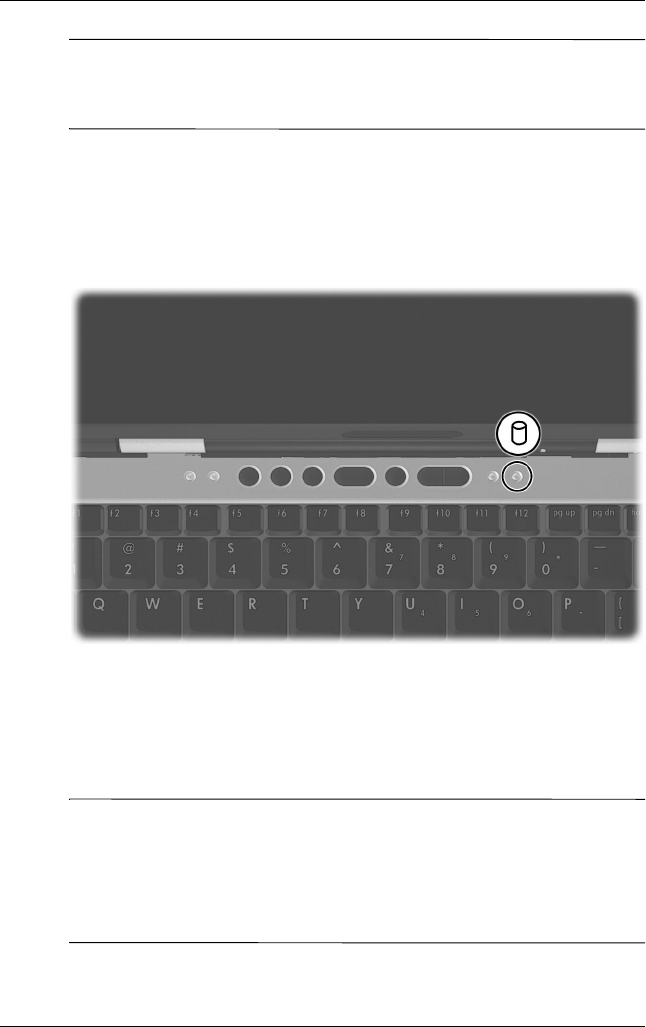
4–2 Hardware Guide
Hard Drive
DRAFT - Revised: 10-28-02
Compaq CONFIDENTIAL—For Internal Use Only
11/13/02
File: SP-CH4-Hard Drives.fm
✎Airport security devices that check carry-on luggage placed on a
conveyor belt use X-rays instead of magnetism and do not
damage hard drives.
Hard Drive Activity Light
The hard drive activity light turns on when the hard drive is being
accessed.
Hard drive activity light
Replacing the Primary Hard Drive
The hard drive in the hard drive bay is the primary hard drive.
ÄCAUTION: To prevent system lockup and loss of information:
■Shut down the notebook before removing the hard drive from
the hard drive bay. Do not remove the hard drive while the
notebook is on, in Standby, or Hibernation.
■If you are not sure whether the notebook is in Hibernation, turn
on the notebook and then shut it down.
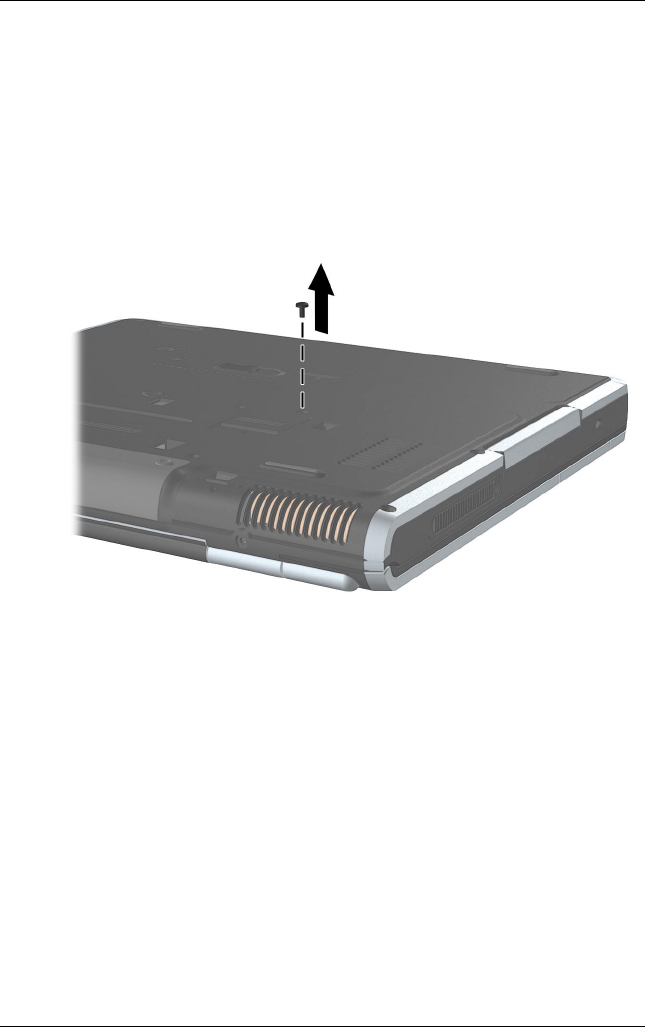
Hard Drive
Hardware Guide 4–3
DRAFT - Revised: 10-28-02
Compaq CONFIDENTIAL—For Internal Use Only
11/13/02
File: SP-CH4-Hard Drives.fm
To replace the primary hard drive:
1. Save your work.
2. Shut down the notebook and close the display.
3. Turn the notebook bottom-side up.
4. Remove the hard drive retaining screw.
Removing the hard drive retaining screw
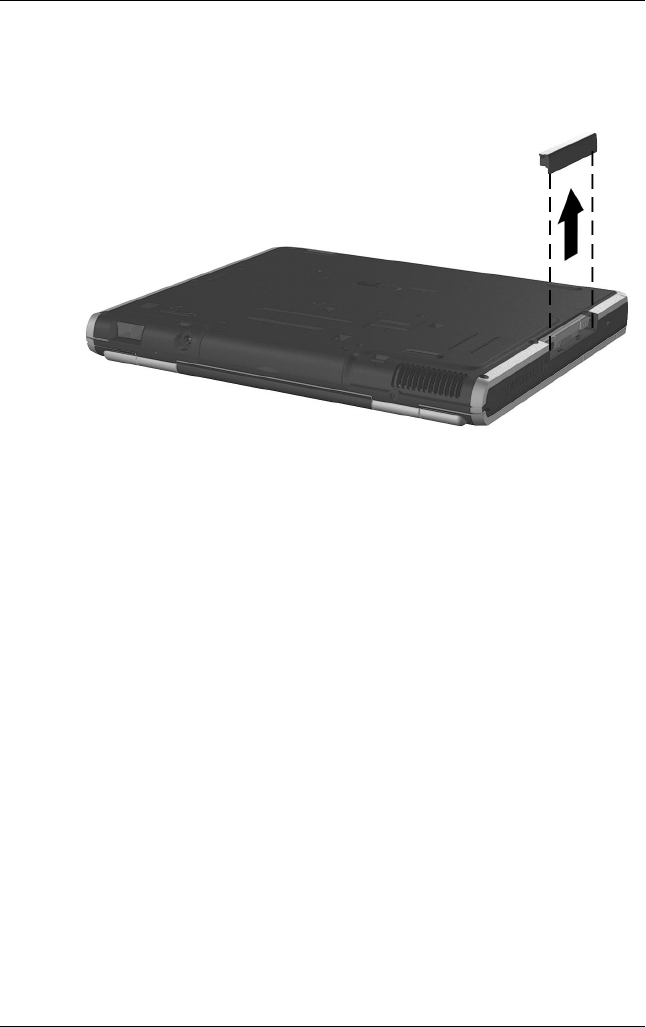
4–4 Hardware Guide
Hard Drive
DRAFT - Revised: 10-28-02
Compaq CONFIDENTIAL—For Internal Use Only
11/13/02
File: SP-CH4-Hard Drives.fm
5. Remove the hard drive bezel.
Removing the hard drive bezel
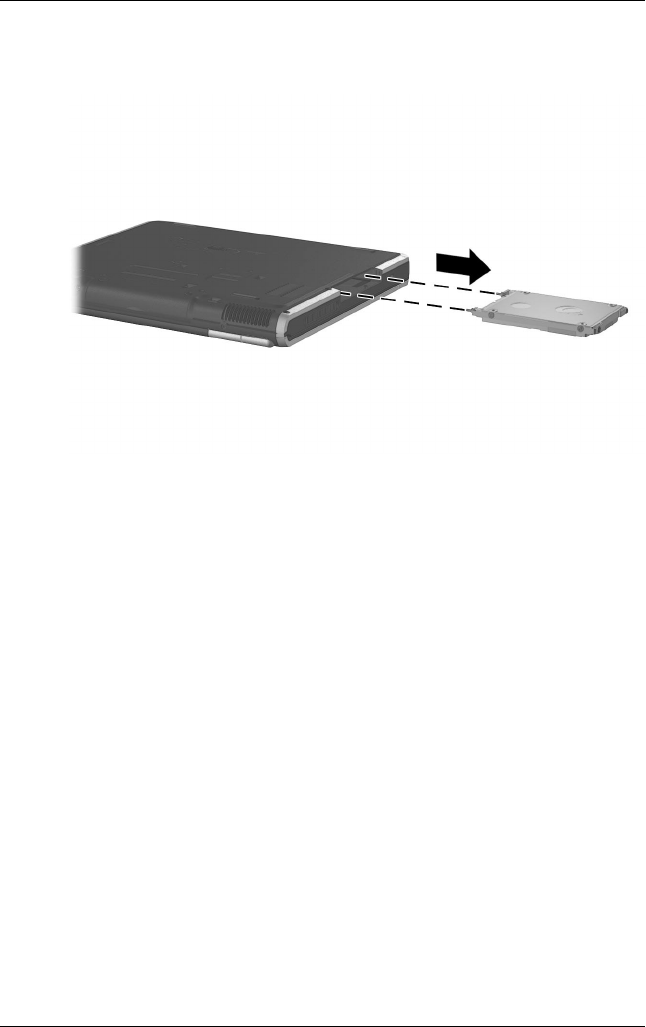
Hard Drive
Hardware Guide 4–5
DRAFT - Revised: 10-28-02
Compaq CONFIDENTIAL—For Internal Use Only
11/13/02
File: SP-CH4-Hard Drives.fm
6. Pull the drive out of the bay.
Removing the hard drive from the hard drive bay
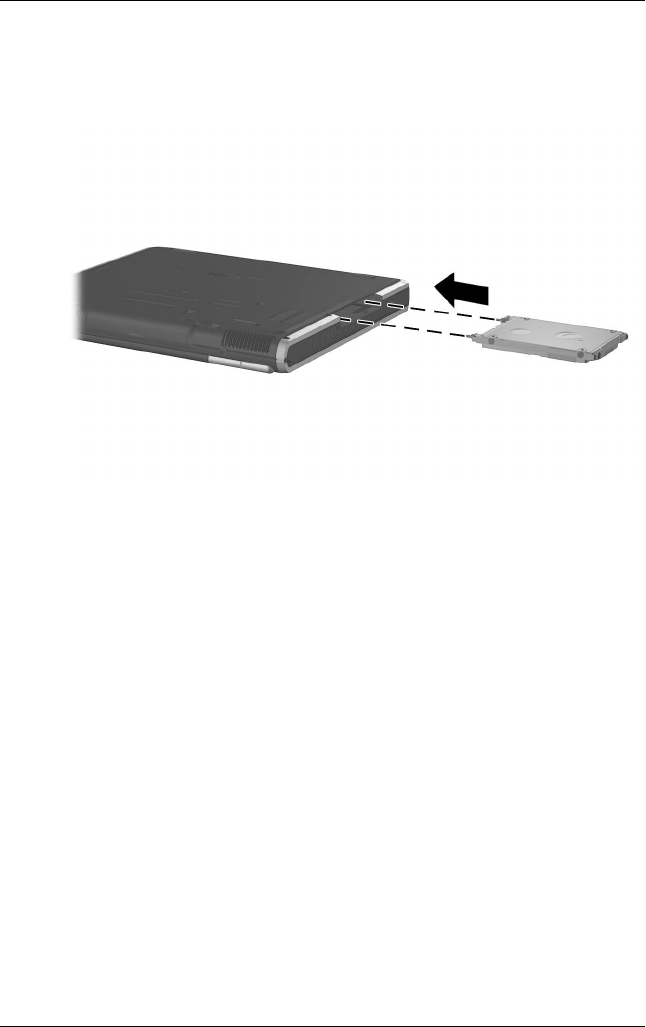
4–6 Hardware Guide
Hard Drive
DRAFT - Revised: 10-28-02
Compaq CONFIDENTIAL—For Internal Use Only
11/13/02
File: SP-CH4-Hard Drives.fm
7. Insert a hard drive by sliding the hard drive into the bay until
the drive is seated.
Inserting the hard drive into the hard drive bay
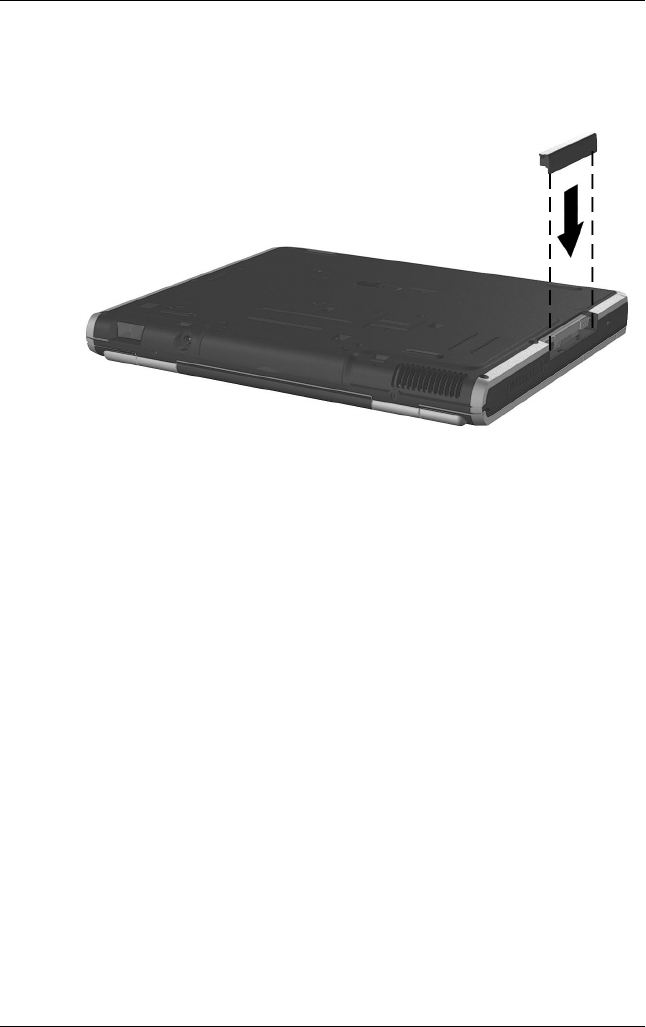
Hard Drive
Hardware Guide 4–7
DRAFT - Revised: 10-28-02
Compaq CONFIDENTIAL—For Internal Use Only
11/13/02
File: SP-CH4-Hard Drives.fm
8. Replace the hard drive bezel.
Replacing the hard drive bezel
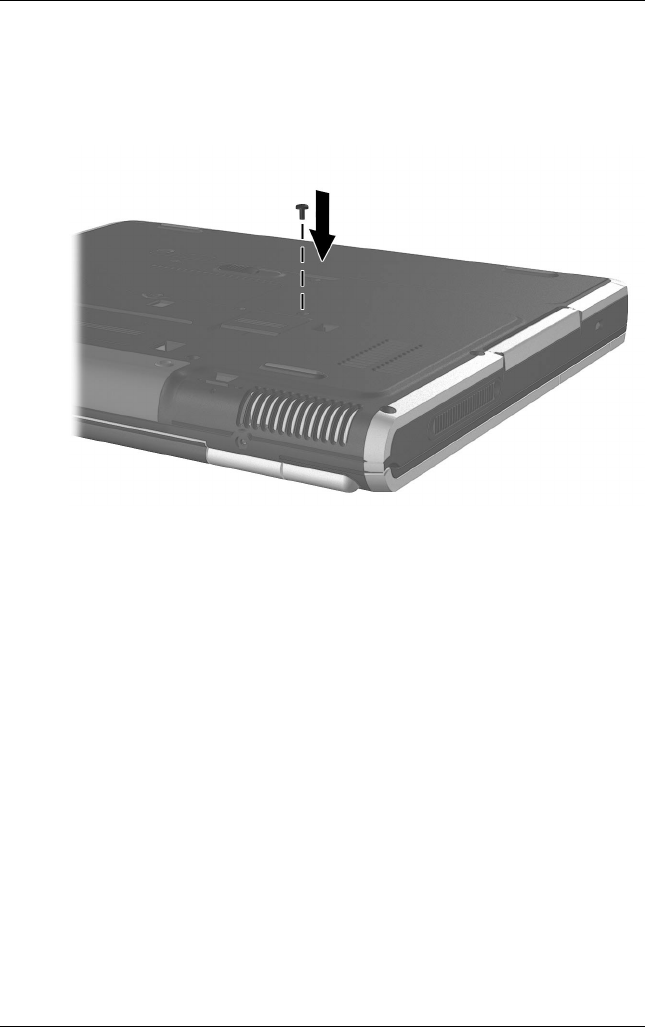
4–8 Hardware Guide
Hard Drive
DRAFT - Revised: 10-28-02
Compaq CONFIDENTIAL—For Internal Use Only
11/13/02
File: SP-CH4-Hard Drives.fm
9. Reinsert the hard drive retaining screw. (If you removed but
did not replace a hard drive, put the retaining screw in a safe
place.)
Replacing the hard drive retaining screw
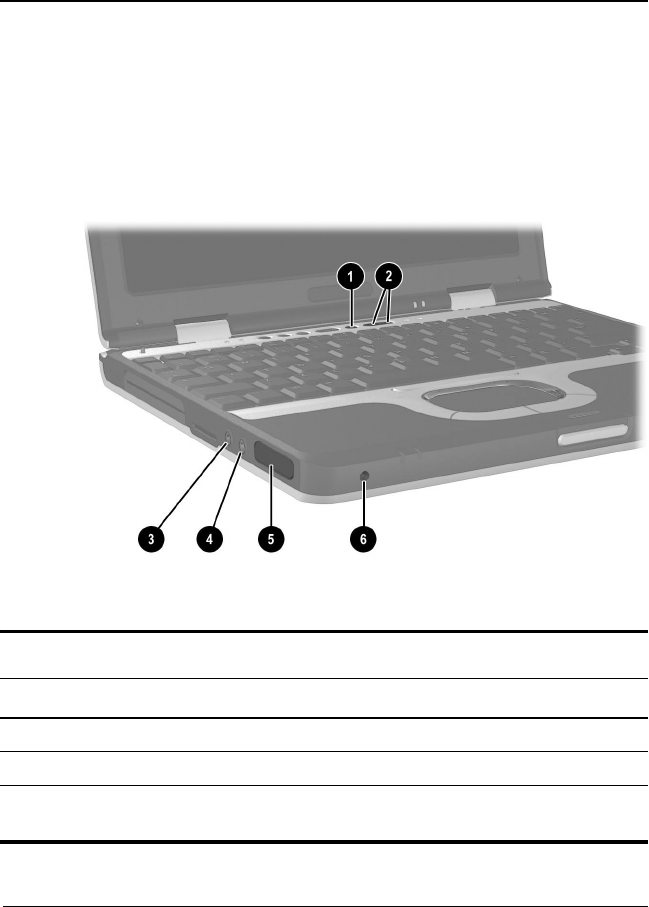
DRAFT - Revised: 10-28-02
Hardware Guide 5–1
Compaq CONFIDENTIAL—For Internal Use Only
11/13/02
File: SP-CH5-Audio and Video.fm
5
Audio and Video
Using Audio Features
The notebook provides the following audio components:
Audio components
Audio Components
Item Component Description
1Mute button Mutes system volume.
2Volume buttons (2) Adjust the system volume.
3Audio line-in jack Connects an optional single-sound
channel microphone.

5–2 Hardware Guide
Audio and Video
DRAFT - Revised: 10-28-02
Compaq CONFIDENTIAL—For Internal Use Only
11/13/02
File: SP-CH5-Audio and Video.fm
Adjusting Volume
To adjust the volume, use any of the following controls:
■Notebook volume buttons
❏To mute or restore volume, press the Quick Launch mute
button. You can also mute or restore volume by pressing
the volume - and volume + buttons simultaneously.
❏To decrease the volume, press the left button.
❏To decrease the volume, press the right button.
■Windows Volume Control window
✎Volume can also be adjusted within some applications.
4Audio line-out jack Connects optional, powered stereo
speakers, headphones, headset, or
television audio.
5Speaker Produces stereo sound.
6Microphone Inputs single-channel sound.
Audio Components (Continued)
Item Component Description

Audio and Video
Hardware Guide 5–3
DRAFT - Revised: 10-28-02
Compaq CONFIDENTIAL—For Internal Use Only
11/13/02
File: SP-CH5-Audio and Video.fm
Using the Audio Line-In Jack
When an external microphone is connected to the notebook, the
notebook microphone is disabled.
When connecting a microphone to the audio line-in jack, use a
single-sound channel (monaural) microphone with a 3.5-mm
plug. A monaural electret condenser microphone is
recommended. Other types of microphones are not fully
functional with the notebook:
■If you connect a stereo microphone, left channel sound will
record on both channels.
■If you connect a dynamic microphone, the recommended
sensitivity may not be achieved.
Using the Audio Line-Out Jack
ÅWARNING: To reduce the risk of personal injury, adjust the volume
before putting on headphones or a headset.
ÄCAUTION: To prevent possible damage to an external device, do
not plug a single-sound channel (monaural) connector into the
audio line-out jack.
When connecting a device to the audio line-out jack, use only a
3.5-mm stereo plug. for best sound quality, use 24-ohm to
32-ohm headphones.
When an external audio device is connected to the audio-out jack,
the notebook stereo speaker is disabled.
Using Video Features
The notebook features an S-video-out jack. An S-video cable
attaches the notebook to an optional S-video device, such as a
television, VCR, camcorder, overhead projector, or video capture
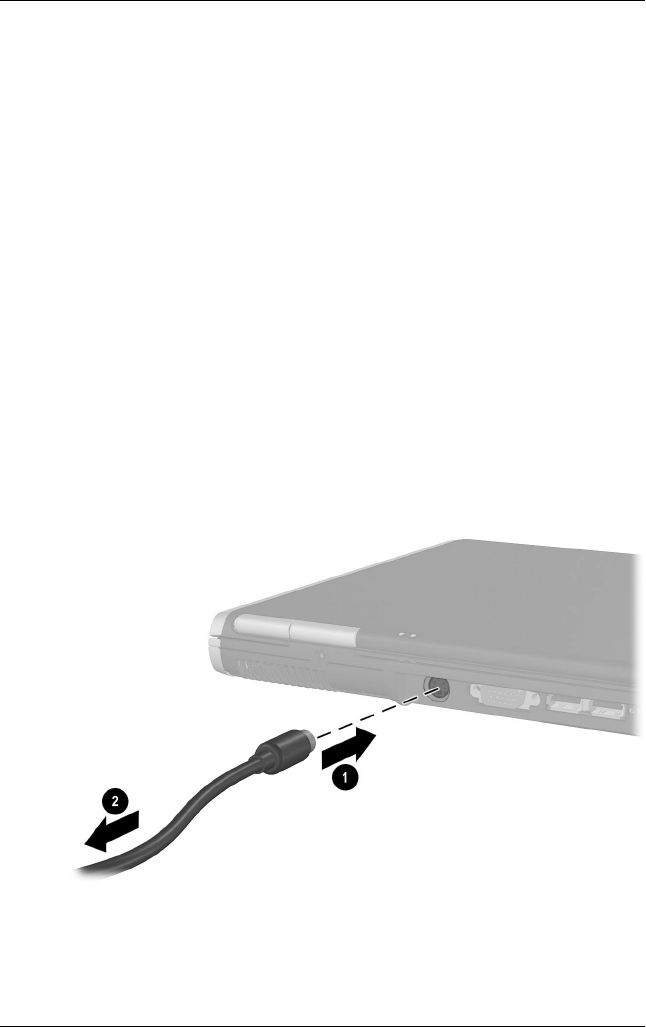
5–4 Hardware Guide
Audio and Video
DRAFT - Revised: 10-28-02
Compaq CONFIDENTIAL—For Internal Use Only
11/13/02
File: SP-CH5-Audio and Video.fm
card. The notebook supports one S-video device connected to the
S-video-out jack while simultaneously supporting an image on
the notebook display and on any other supported external display.
To transmit video signals through the S-video-out jack, you need
an S-video cable available from most electronic retailers. If you
are combining audio and video functions, such as playing a movie
from a DVD in an optional MultiBay to a television, you also
need a standard audio cable available from most electronics
retailers.
Connecting a Device to the S-Video-Out Jack
To connect a video device to the S-video-out jack:
1. Plug either end of the S-video cable into the S-video-out jack
on the notebook 1.
2. Connect the other end of the cable to the video device as
instructed in the documentation included with the device 2.
Connecting a device to the S-video-out jack

Audio and Video
Hardware Guide 5–5
DRAFT - Revised: 10-28-02
Compaq CONFIDENTIAL—For Internal Use Only
11/13/02
File: SP-CH5-Audio and Video.fm
✎If the S-video-out jack on the notebook is not accessible while the
notebook is docked, you can connect the device to the
S-video-out jack on the optional Port Replicator.
Changing the Video Mode
The default color television standard mode of the notebook is
NTSC. Color television standard modes vary even within regions.
However, NTSC is common in North America; PAL is common
is Europe, China, Africa, and the Middle East; NTSC-J is
common in Japan; and PAL-M is common in Brazil. Other South
and Central American regions may use NTSC, PAL, or PAL-M.
To change the color television standard mode from NTSC:
1. Turn on or restart the notebook.
2. Press F10 while the F10 = ROM Based Setup message is
displayed in the lower left corner of the screen.
❏To change the language, press F2.
❏For navigation instructions, press F1.
3. Select Advanced > Device Options, then press enter.
4. Enter your preference, then press F10.
5. To save your preference and exit Computer Setup, select
File > Save Changes and Exit, then follow the instructions on
the screen.

DRAFT - Revised: 10-28-02
Hardware Guide 6–1
Compaq CONFIDENTIAL—For Internal Use Only
11/13/02
File: SP-CH6-Communication Devices.fm
6
Communication Devices
Connecting a Modem Cable
A modem cable, which has a 6-pin RJ-11 connector at each end,
must be connected to an analog telephone line. Jacks for digital
PBX systems may resemble analog telephone jacks, but are not
compatible with the modem.
ÅWARNING: Connecting the notebook to a digital line can
permanently damage the modem. Immediately disconnect your
modem cable if accidentally connected to a digital line.
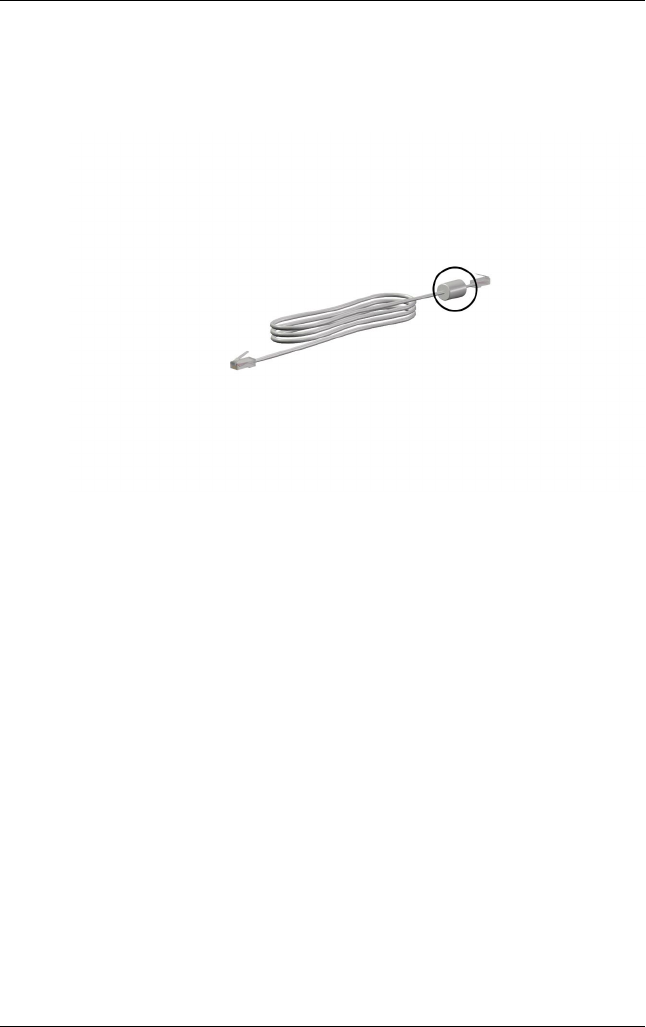
6–2 Hardware Guide
Communication Devices
DRAFT - Revised: 10-28-02
Compaq CONFIDENTIAL—For Internal Use Only
11/13/02
File: SP-CH6-Communication Devices.fm
If the modem cable contains noise suppression circuitry, which
prevents interference from TV and radio reception, orient the
circuitry end of the cable toward the notebook.
RJ-11 modem cable with noise suppression circuitry
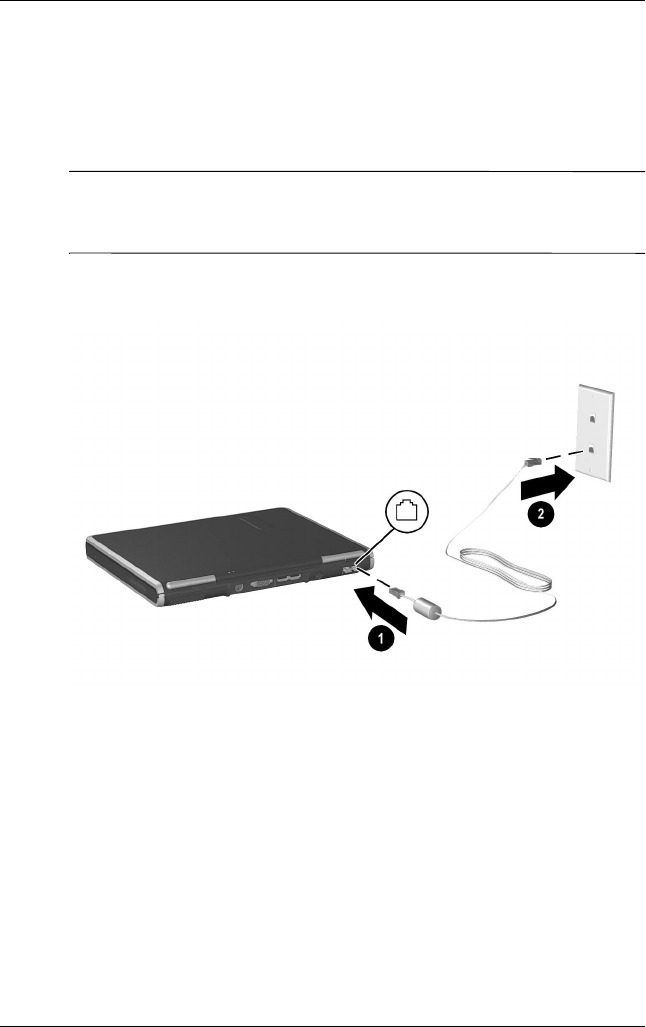
Communication Devices
Hardware Guide 6–3
DRAFT - Revised: 10-28-02
Compaq CONFIDENTIAL—For Internal Use Only
11/13/02
File: SP-CH6-Communication Devices.fm
Using the RJ-11 Cable
To connect an RJ-11 modem cable:
1. Plug the modem cable into the RJ-11 jack on the notebook 1.
ÅWARNING: To reduce the risk of electrical shock, fire, or damage to
the equipment, do not plug a telephone cable into the RJ-45
network jack.
2. Plug the modem cable into the RJ-11 telephone jack 2.
Connecting the RJ-11 modem cable
For more information about using the modem or about using AT
commands and dial modifiers, refer on this CD to the Modem and
Networking guide or the Modem Command Guidelines
(Advanced Users Only) guide.
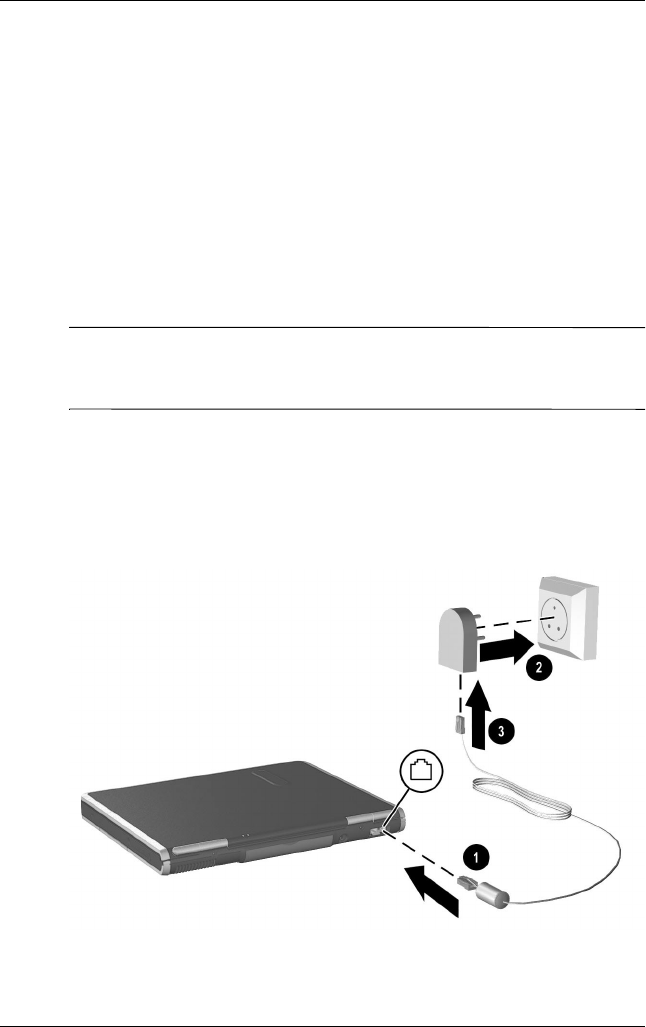
6–4 Hardware Guide
Communication Devices
DRAFT - Revised: 10-28-02
Compaq CONFIDENTIAL—For Internal Use Only
11/13/02
File: SP-CH6-Communication Devices.fm
Using a Country-Specific Adapter Cable
Telephone jacks vary by country. To use the modem and the
RJ-11 cable outside the country in which you purchased the
notebook, you must obtain a country-specific modem adapter.
Refer on this CD to the Modem and Networking guide for more
details about using your notebook internationally.
To connect the modem to an analog telephone line that does not
have an RJ-11 telephone jack:
1. Plug the modem cable into the RJ-11 jack on the notebook 1.
ÅWARNING: To reduce the risk of electrical shock, fire, or damage to
the equipment, do not plug a telephone cable into the RJ-45
network jack.
2. Plug the country-specific modem adapter into the telephone
jack 2.
3. Plug the modem cable into the country-specific modem
adapter.
Connecting a modem cable using a modem adapter
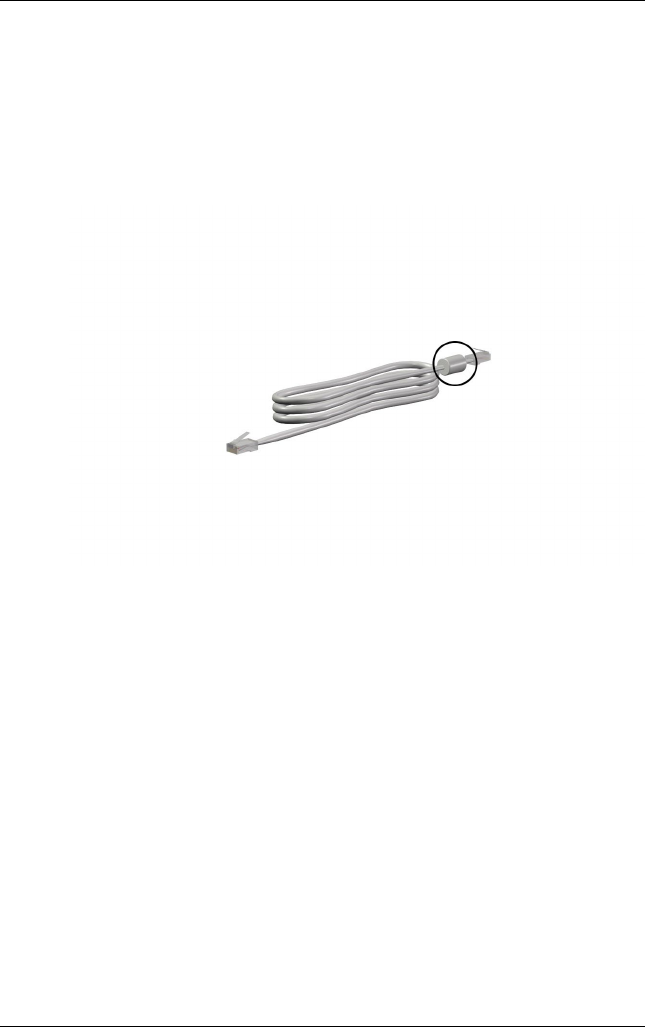
Communication Devices
Hardware Guide 6–5
DRAFT - Revised: 10-28-02
Compaq CONFIDENTIAL—For Internal Use Only
11/13/02
File: SP-CH6-Communication Devices.fm
Connecting a Network Cable
A network cable has an 8-pin RJ-45 connector at each end. If the
network cable contains noise suppression circuitry, which
prevents interference from TV and radio reception, orient the
circuitry end of the cable toward the notebook.
RJ-45 network cable with noise suppression circuitry
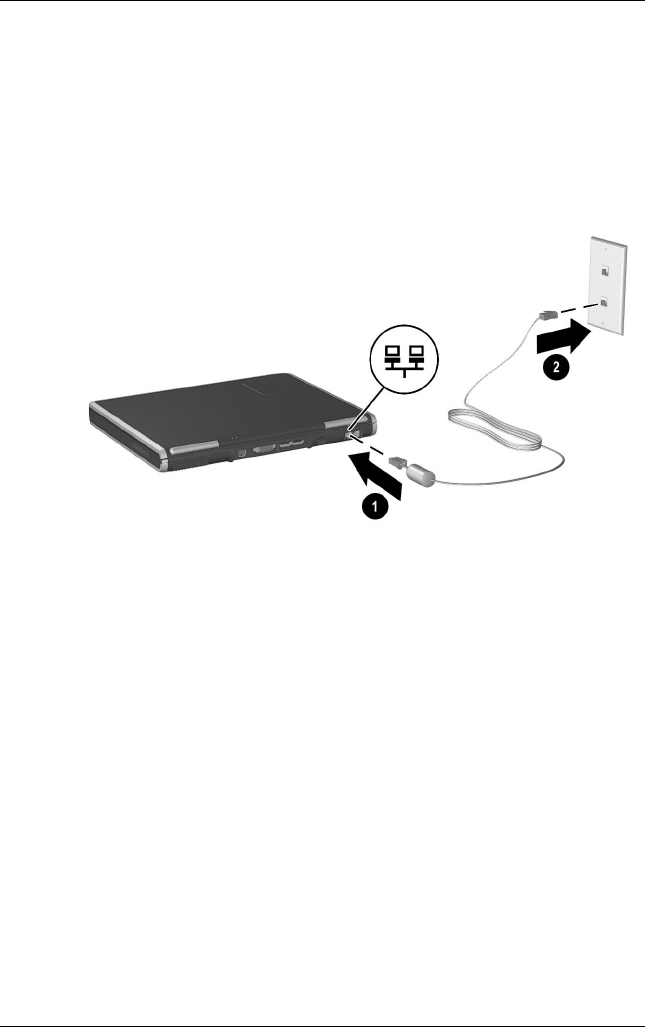
6–6 Hardware Guide
Communication Devices
DRAFT - Revised: 10-28-02
Compaq CONFIDENTIAL—For Internal Use Only
11/13/02
File: SP-CH6-Communication Devices.fm
To connect the network cable:
1. Plug the network cable into the RJ-45 jack on the
notebook 1.
2. Plug the other end of the cable into a network jack 2.
Connecting a network cable
3. Start or restart the notebook.
4. Connect to the network.
Linking to an Infrared Device
The notebook is IrDA-compliant—4 megabits per second (Mbps)
standard—and can communicate with another infrared-equipped
device that is also IrDA-compliant.
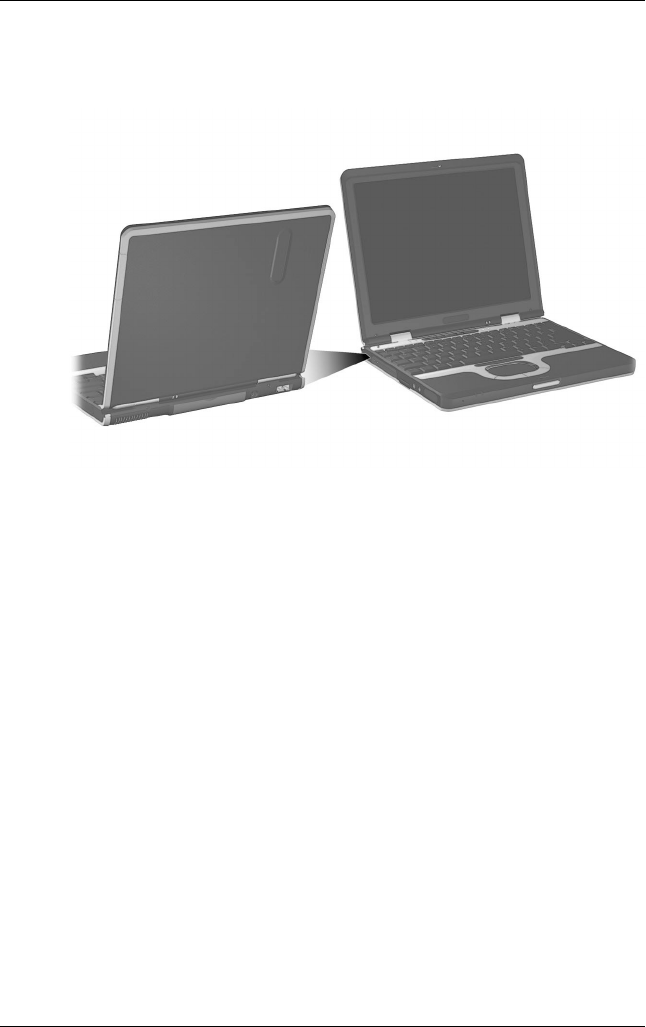
Communication Devices
Hardware Guide 6–7
DRAFT - Revised: 10-28-02
Compaq CONFIDENTIAL—For Internal Use Only
11/13/02
File: SP-CH6-Communication Devices.fm
Infrared signals are sent through an invisible beam of infrared
light and require an unobstructed line of sight path.
Linking to an infrared device
The infrared port supports both low speed connections of up to
115 kilobits per second (Kbps) and high speed connections of up
to 4 Mbps. Infrared performance may vary depending on the
performance of infrared peripherals, distance between infrared
devices, and applications used.
Setting Up an Infrared Transmission
For information about using infrared software, refer to your
operating system Help file.
To set up infrared devices for optimal transmission:
■Prepare the infrared ports on both devices for transmission.
■Position the devices so that their infrared ports face one
another at a distance no greater than 1 meter (3.3 feet).
■Position the ports so that they face one another directly.
Because the maximum capture angle is 30 degrees, the ports
must be aligned no more than 15 degrees off-center.

6–8 Hardware Guide
Communication Devices
DRAFT - Revised: 10-28-02
Compaq CONFIDENTIAL—For Internal Use Only
11/13/02
File: SP-CH6-Communication Devices.fm
■Shield the ports from direct sunlight, flashing incandescent
light, and energy-saving fluorescent light.
■Be sure that no signals from remote control or other wireless
devices, such as headphones or audio devices, aim at a port.
■During the transmission, do not move either device and do
not allow objects or movement to disrupt the beam.
Using Standby with Infrared
Standby is not compatible with infrared transmission. If the
notebook is in Standby, an infrared transmission cannot be
initiated. If Standby is initiated during an infrared transmission,
the transmission stops. To resume from Standby, press the
power/standby button. The transmission resumes when the
notebook resumes from Standby. However, any program that was
using the infrared transmission when Standby was initiated may
not continue at the point it was stopped. For example, if a
program was printing when Standby was initiated, the program
resumes transmission after the notebook resumes, but the print
job may not resume.
Using Wireless LAN
The notebook provides internal wireless LAN supported through
the mini PCI board. For more information on using your internal
wireless LAN, refer on this CD to the Software Guide, “Wireless
LAN Software” chapter or to the wireless mini PCI card
documentation that ships with the notebook.

DRAFT - Revised: 10-28-02
Hardware Guide 7–1
Compaq CONFIDENTIAL—For Internal Use Only
11/7/02
File: SP-CH7-External Devices.fm
7
External Devices
The jacks and connectors described in this guide support the
standard external devices that specify them.
■For information about which jack or connector to use, refer to
the documentation included with the device.
■For information about installing or loading any software,
such as drivers, required by the device, refer to the
documentation included with the device.
To connect a standard external device to the notebook:
1. Turn off the notebook.
2. If you are connecting a powered device, turn off the device.
3. Connect the device to the connector on the notebook.
4. If you are connecting a powered device, plug the device
power cord into a grounded electrical outlet.
5. Turn on the device.
6. Turn on the notebook.
To disconnect a standard external device from the notebook, turn
off the device, then disconnect the device from the notebook.
Connecting a Monitor or Projector
To connect an external monitor or projector to the notebook,
insert the monitor cable into the external monitor connector on
the back of the notebook.
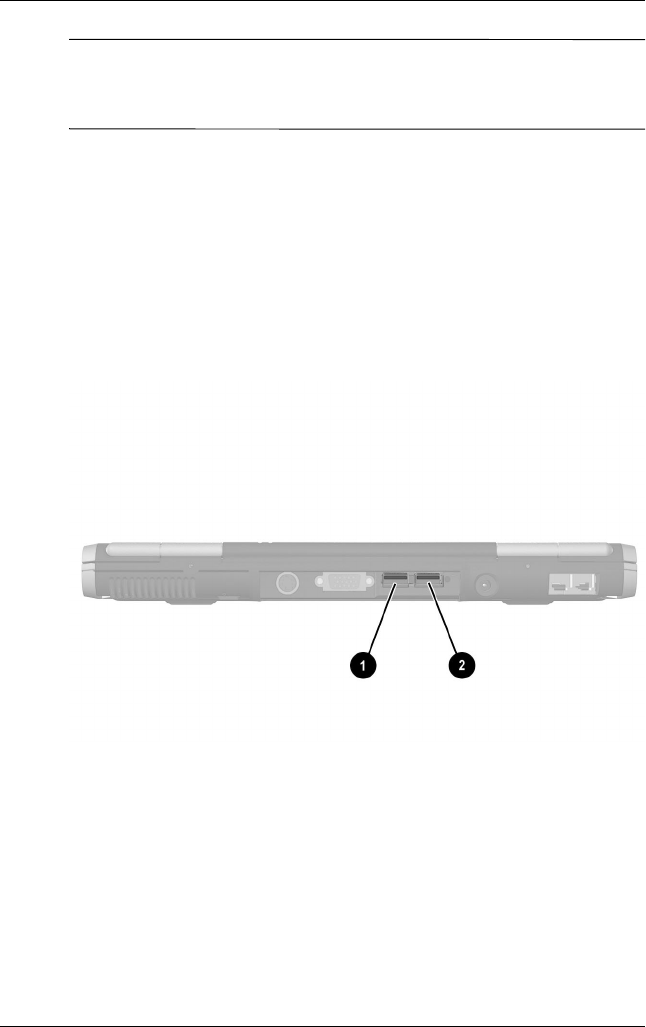
7–2 Hardware Guide
External Devices
DRAFT - Revised: 10-28-02
Compaq CONFIDENTIAL—For Internal Use Only
11/7/02
File: SP-CH7-External Devices.fm
✎If a properly connected external monitor or projector does not
display an image, try pressing the Fn+F4 hotkeys to switch the
image to the monitor.
Using a USB Device
Universal serial bus (USB) is a hardware interface that can be
used to connect external devices, such as a USB keyboard,
mouse, drive, printer, scanner, or hub, to the notebook. The
notebook has a USB connector 1 and a USB connector with
power 2. The USB connectors support USB 2.0 and USB 1.1
devices.
USB connectors on the rear panel
USB hubs can be connected to a USB connector on the notebook
or a Port Replicator or to other USB devices. Hubs support
varying numbers of USB devices and are used to increase the
number of USB devices in the system. Powered hubs must be
connected to external power. Unpowered hubs must be connected
either to a USB connector on the notebook or to a port on a
powered hub.

External Devices
Hardware Guide 7–3
DRAFT - Revised: 10-28-02
Compaq CONFIDENTIAL—For Internal Use Only
11/7/02
File: SP-CH7-External Devices.fm
Using a USB Device
A USB device functions in the same way as a comparable
non-USB device, with one exception. By default, USB devices do
not function unless an operating system that supports USB is
loaded.
Some USB devices may require additional support software,
which is usually included with the device. For more information
and software installation instructions, refer to the documentation
included with the device.
Enabling USB Legacy Support
To use a USB keyboard, mouse, or hub connected to a USB
connector on the notebook during startup or in a non-Windows
application or utility, enable USB legacy support.
To enable USB legacy support:
1. Turn on or restart the notebook.
2. Press F10 while the F10 = ROM Based Setup message is
displayed in the lower left corner of the screen.
❏To change the language, press F2.
❏For navigation instructions, press F1.
3. Select Advanced menu > Device Options.
4. Select Enable USB legacy support.
5. To save your preference and exit Computer Setup, select
File > Save Changes and Exit, then follow the instructions on
the screen.
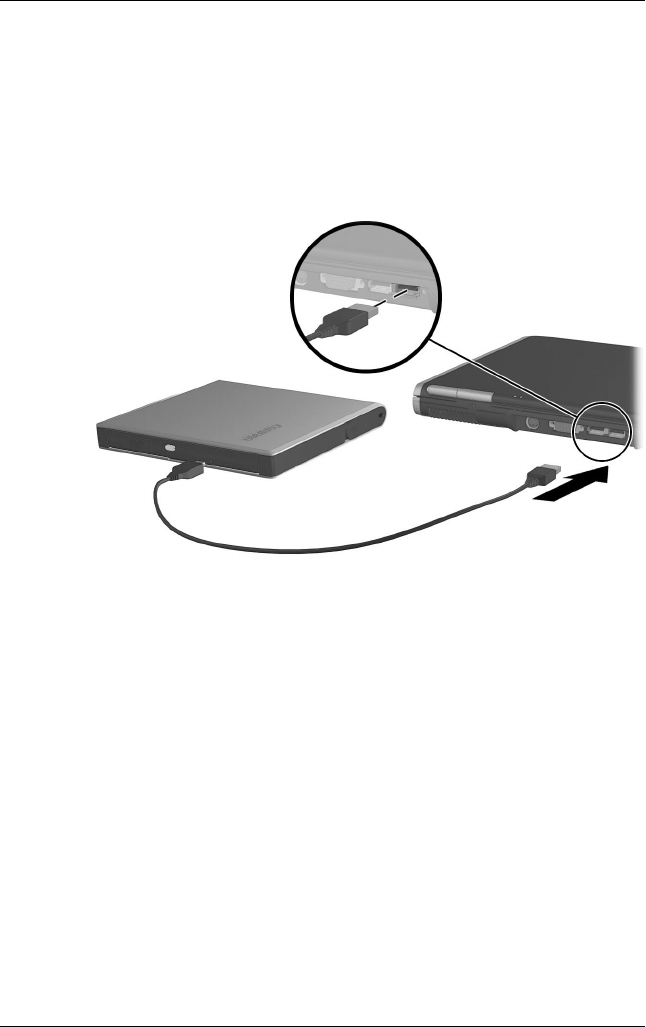
7–4 Hardware Guide
External Devices
DRAFT - Revised: 10-28-02
Compaq CONFIDENTIAL—For Internal Use Only
11/7/02
File: SP-CH7-External Devices.fm
Using an Optional External MultiBay
An external MultiBay connects to the notebook using the USB
with power connector. For more information about the external
MultiBay, refer to the documentation that is included with the
device.
Connecting an external MultiBay
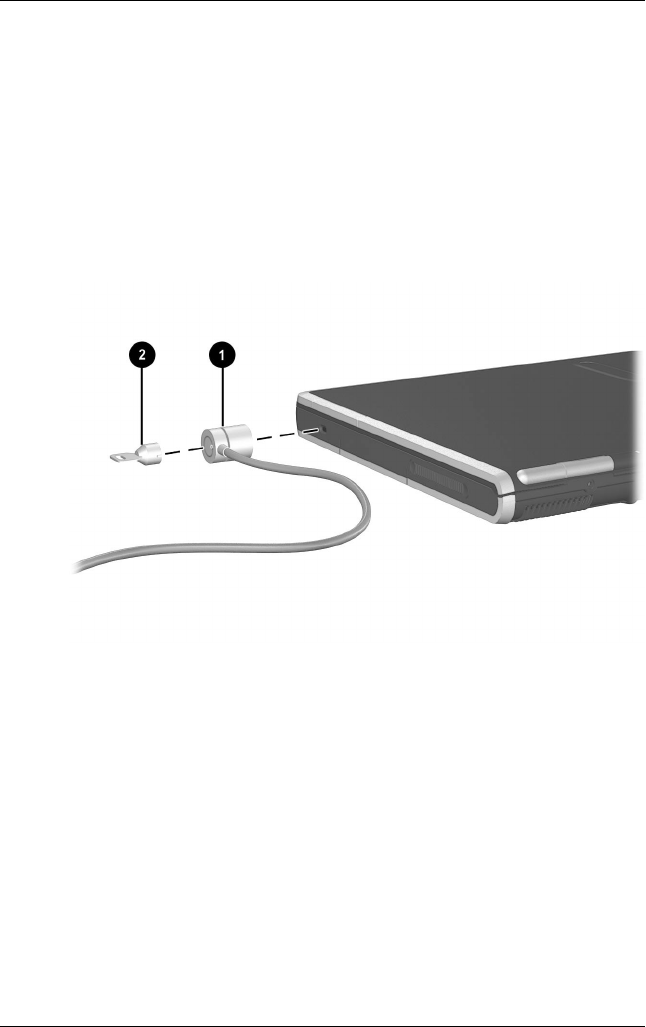
External Devices
Hardware Guide 7–5
DRAFT - Revised: 10-28-02
Compaq CONFIDENTIAL—For Internal Use Only
11/7/02
File: SP-CH7-External Devices.fm
Connecting an Optional Cable Lock
To install a security cable:
1. Loop the security cable around a secured object.
2. Pull the security cable lock through the cable loop and insert
the cable 1 into the security cable slot on the notebook.
3. If the cable has a key 2, use it to lock and unlock the cable.
Connecting a security cable

DRAFT - Revised: 10-28-02
Hardware Guide 8–1
Compaq CONFIDENTIAL—For Internal Use Only
11/13/02
File: SP-CH8-Hardware Upgrades.fm
8
Hardware Upgrades
To order hardware or learn more about upgrades and accessories,
visit the HP Web site at http://www.hp.com or contact an authorized
dealer, reseller, or service provider. For information about
obtaining and installing software updates and upgrades, refer on
this CD to the Software Guide, “Software Updates and
Restorations” chapter.
Using PC Cards
A PC Card is a credit card-sized accessory designed to conform
to the standard specifications of the Personal Computer Memory
Card International Association (PCMCIA). The notebook
supports both 32-bit CardBus and 16-bit PC Cards, and it
supports Type I and Type II cards. Zoomed video PC Cards are
not supported.
ÄCAUTION: If you install all of the software or any of the enablers
provided by a PC Card manufacturer, you may not be able to use other
PC Cards. If you are instructed by the documentation included with your
PC Card to install device drivers:
■Install only the device drivers for your operating system.
■Do not install other software, such as card services, socket
services, or enablers, that may also be supplied by the PC Card
manufacturer.
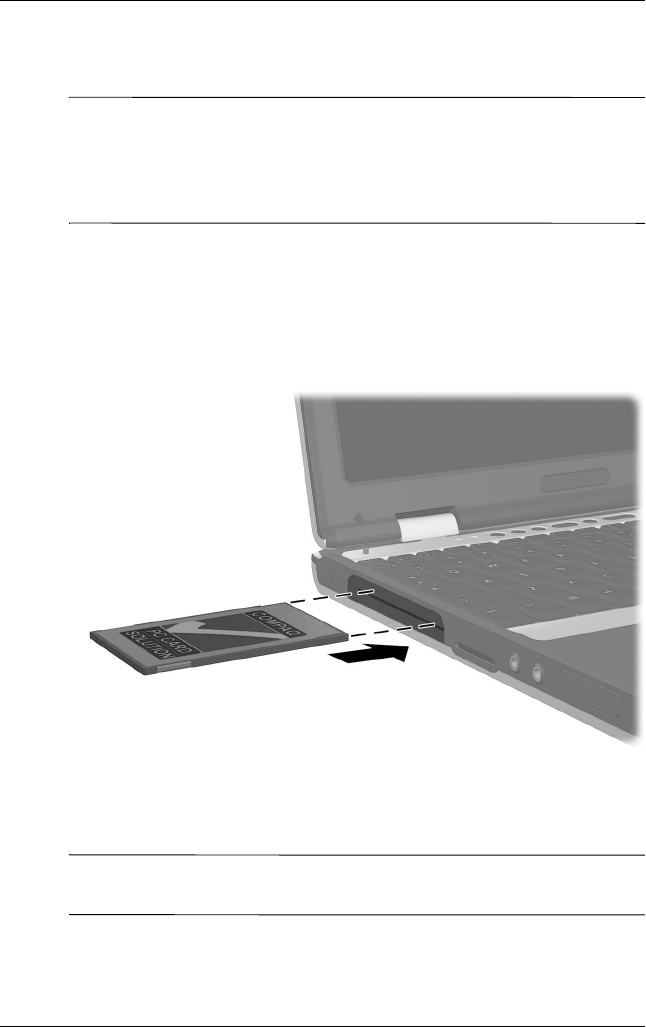
8–2 Hardware Guide
Hardware Upgrades
DRAFT - Revised: 10-28-02
Compaq CONFIDENTIAL—For Internal Use Only
11/13/02
File: SP-CH8-Hardware Upgrades.fm
Inserting a PC Card
ÄCAUTION: To prevent damage to the connectors:
■Use minimal pressure when inserting a PC Card into a PC Card
slot.
■Do not move or transport the notebook while a PC Card is
inserted.
To insert a PC Card:
1. Hold the PC Card label-side up with the connector facing the
notebook.
2. Gently push the card into the slot until the card is seated.
Inserting a PC Card into the PC Card slot
Removing a PC Card
ÄCAUTION: To prevent loss of work or system lockup, stop the PC
Card before removing it.
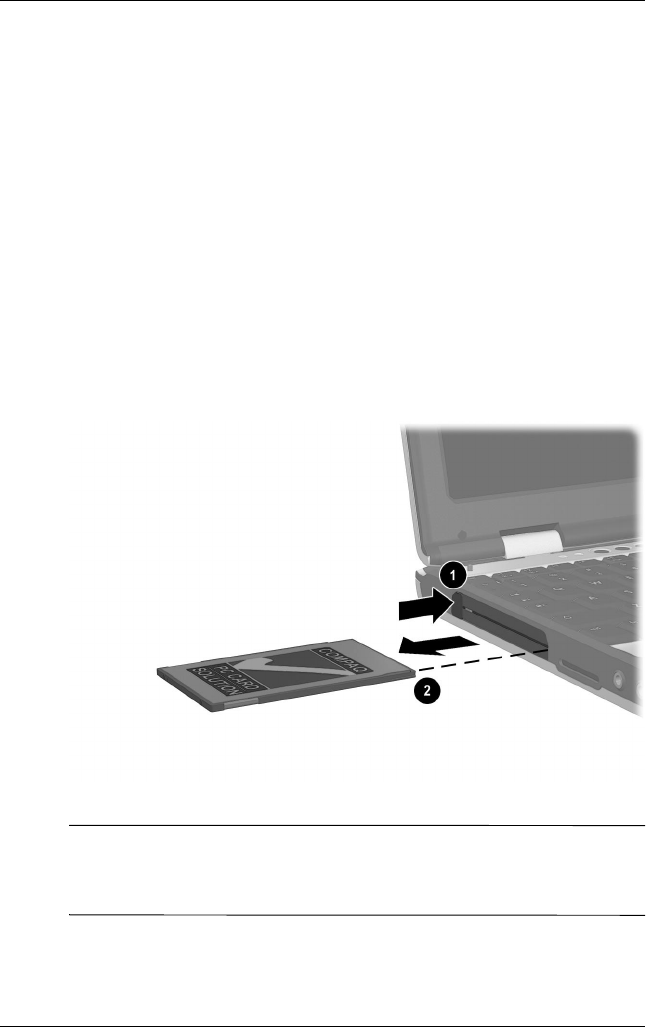
Hardware Upgrades
Hardware Guide 8–3
DRAFT - Revised: 10-28-02
Compaq CONFIDENTIAL—For Internal Use Only
11/13/02
File: SP-CH8-Hardware Upgrades.fm
To remove a PC Card:
1. Stop the PC Card:
❏In Windows 2000 Professional, select the Unplug or
Eject icon in the task bar, then stop the card you plan to
remove. (When the card can be safely removed, a
message is displayed.)
❏In Windows XP Professional, select the Sfely Remove
Hardware icon in the taskbar, then select the PC Card.
(To display the Safely Remove Hardware icon, select
Show Hidden Icons in the taskbar.)
2. Press the PC Card eject button 1.
3. Gently pull out the card 2.
Removing a PC Card
✎An inserted PC Card uses power even when not in use. To
conserve power, stop or remove a PC Card when you are not
using it.
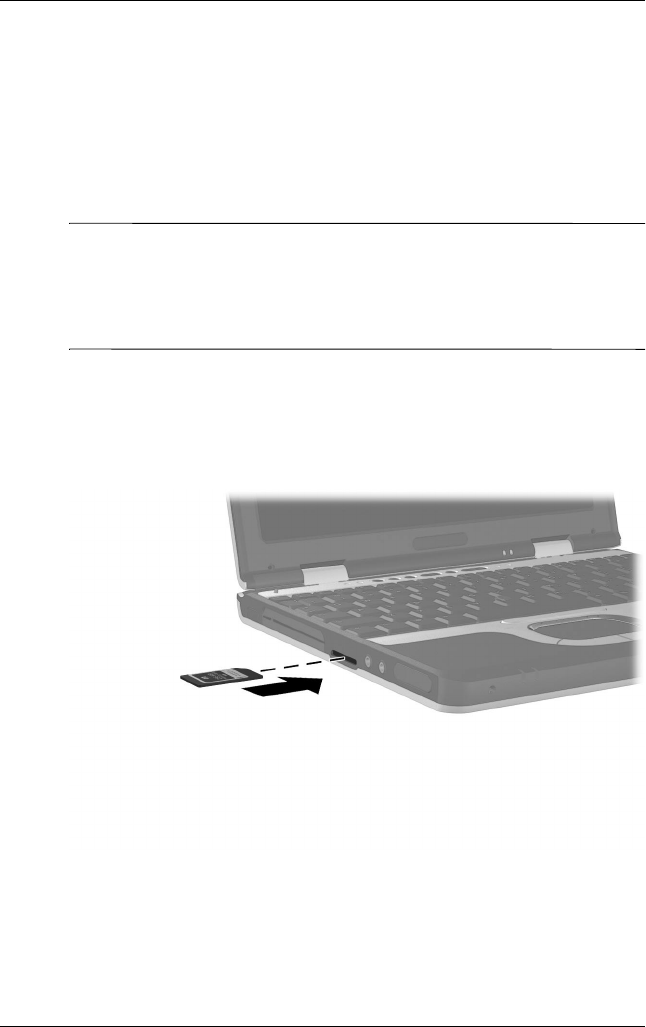
8–4 Hardware Guide
Hardware Upgrades
DRAFT - Revised: 10-28-02
Compaq CONFIDENTIAL—For Internal Use Only
11/13/02
File: SP-CH8-Hardware Upgrades.fm
Using SD Cards
Secure Digital (SD) cards are postage stamp-sized accessories
that increase the memory capacity of your notebook.
Inserting an SD Card
ÄCAUTION: To prevent damage to the connectors:
■Use minimal pressure when inserting an SD card into an SD
card slot.
■Do not move or transport the notebook while an SD card is
inserted.
To insert an SD card:
1. Insert the SD card into the SD slot.
2. Push the card firmly into the slot until it clicks into place.
Inserting an SD card into the SD slot
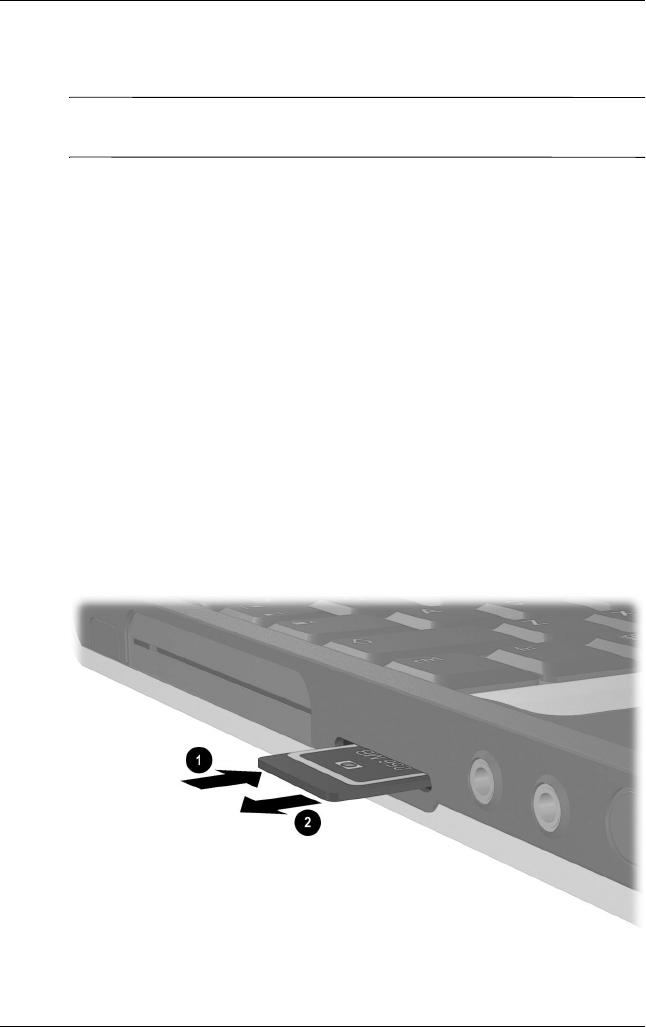
Hardware Upgrades
Hardware Guide 8–5
DRAFT - Revised: 10-28-02
Compaq CONFIDENTIAL—For Internal Use Only
11/13/02
File: SP-CH8-Hardware Upgrades.fm
Removing an SD Card
ÄCAUTION: To prevent loss of work or system lockup, stop the SD
card before removing it.
To remove an SD card:
1. Close all files and applications using the SD card.
2. Stop the SD card.
❏In Windows 2000 Professional, select the Unplug or
Eject icon in the task bar, then stop the card you plan to
remove. (When the card can be safely removed, a
message is displayed.)
❏In Windows XP, select the Safely Remove Hardware
icon in the taskbar, then select the PC Card. (To display
the Safely Remove Hardware icon, select Show Hidden
Icons in the taskbar.)
3. Gently press in on the SD card to unlock it 1.
4. Pull the SD card from the slot 2.
Ejecting an SD card from the SD slot

8–6 Hardware Guide
Hardware Upgrades
DRAFT - Revised: 10-28-02
Compaq CONFIDENTIAL—For Internal Use Only
11/13/02
File: SP-CH8-Hardware Upgrades.fm
Adding and Upgrading Memory Boards
ÅWARNING: The memory compartments are the only
user-accessible internal compartments on the notebook. All other
areas that require a tool to access should be opened only by an
authorized service provider.
ÅWARNING: Failure to unplug the power cord and remove all battery
packs before installing a memory expansion board can damage the
equipment and expose you to the risk of electrical shock.
ÄCAUTION: Electrostatic discharge (ESD) can damage electronic
components. Before beginning any procedure, ensure that you are
discharged of static electyricity by touching a grounded metal
object. For more information, refer on this CD to the Regulatory and
Safety Notices guide.
The notebook has 2 memory slots. The primary memory slot is
located under the keyboard. The primary memory slot is
populated at the factory. The memory expansion slot is located on
the bottom of the notebook.
The memory capacity of the notebook can be upgraded first by
adding a memory board to the expansion slot and then by
upgrading the memory board in the primary memory slot.
Adding a Memory Expansion Board
To add a memory expansion board:
1. Shut down the notebook. (If you are not sure whether the
notebook is off or in Hibernation, turn the notebook on by
pressing the power/standby button. Then shut down the
notebook through the operating system.)
2. Disconnect all external devices connected to the notebook.
3. Disconnect the power cord.
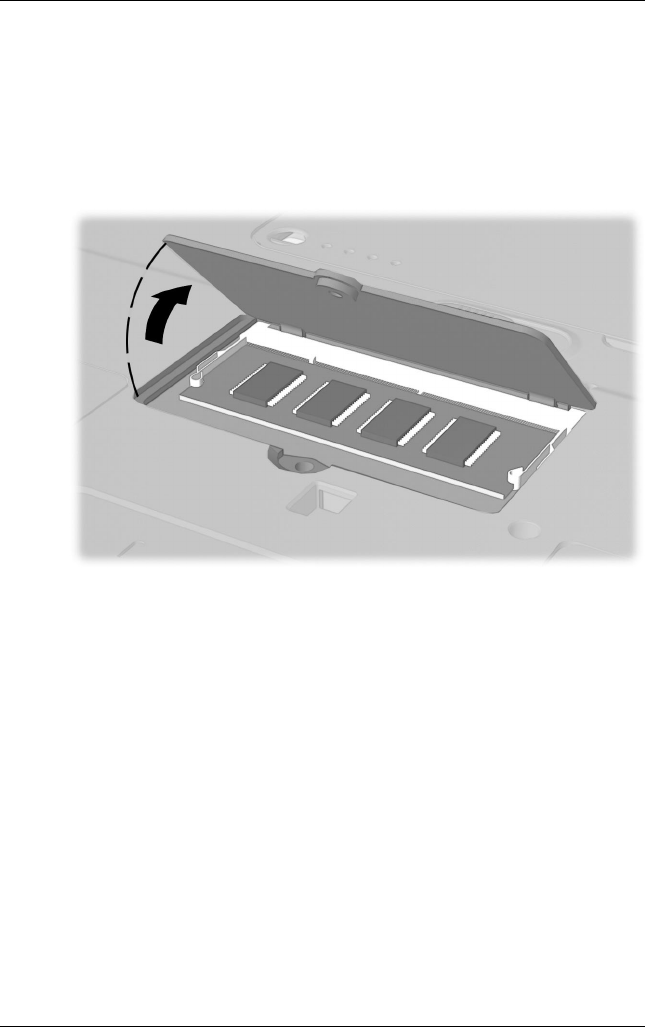
Hardware Upgrades
Hardware Guide 8–7
DRAFT - Revised: 10-28-02
Compaq CONFIDENTIAL—For Internal Use Only
11/13/02
File: SP-CH8-Hardware Upgrades.fm
4. Turn the notebook bottom-side up.
5. Remove any battery packs from the notebook.
6. Remove the screw from the memory expansion slot cover 1.
7. Remove the memory expansion slot cover 2.
Removing the expansion slot cover
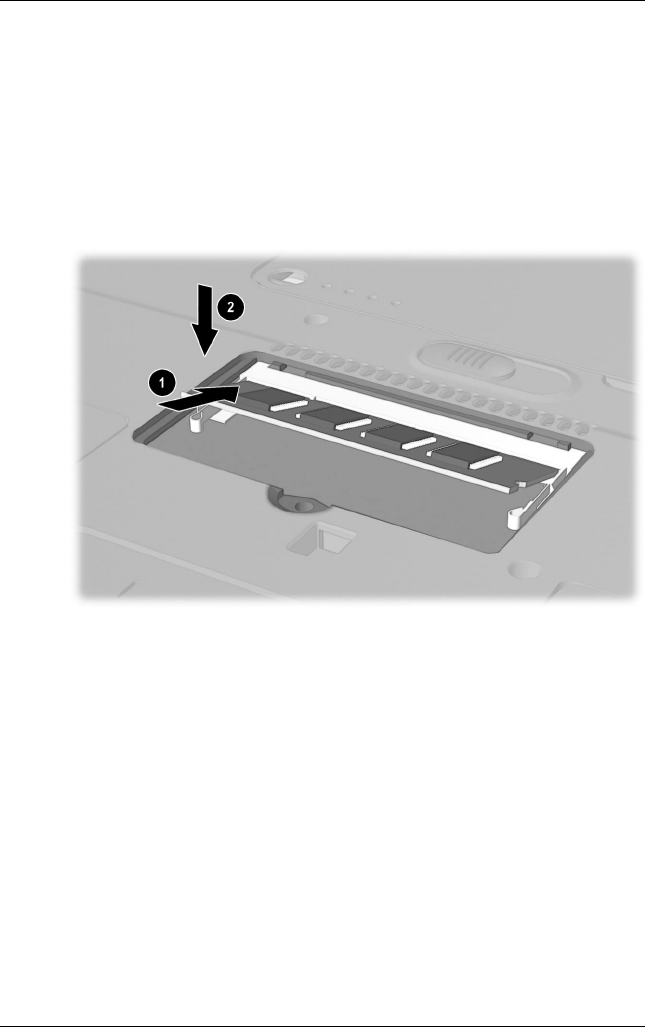
8–8 Hardware Guide
Hardware Upgrades
DRAFT - Revised: 10-28-02
Compaq CONFIDENTIAL—For Internal Use Only
11/13/02
File: SP-CH8-Hardware Upgrades.fm
8. Insert the memory expansion board:
a. Align the keyed (notched) edge of the board with the
keyed area in the expansion slot 1.
b. Press the board into the slot from a 45-degree angle until
it is seated, then push the board downward until the
retention clips snap into place 2.
Inserting a memory expansion board
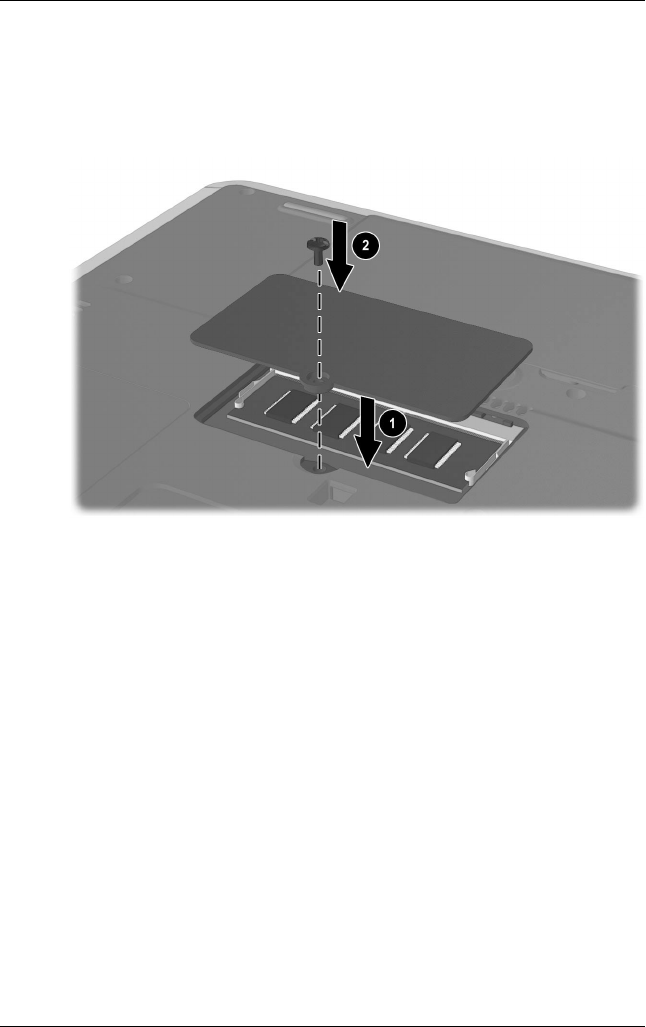
Hardware Upgrades
Hardware Guide 8–9
DRAFT - Revised: 10-28-02
Compaq CONFIDENTIAL—For Internal Use Only
11/13/02
File: SP-CH8-Hardware Upgrades.fm
9. Replace the expansion slot cover over the expansion board
compartment 1.
10. Replace the expansion slot cover screw 2.
11. Replace the battery packs.
12. Reconnect AC power and external devices.
13. Restart the notebook.
Upgrading the Memory Board in the Primary
Memory Slot
To upgrad the memory board in the primary memory slot:
1. Shut down the notebook. (If you are not sure whether the
notebook is off or in Hibernation, turn the notebook on by
pressing the power/standby button. Then shut down the
notebook through the operating system.)
2. Disconnect all external devices connected to the notebook.
3. Disconnect the power cord.
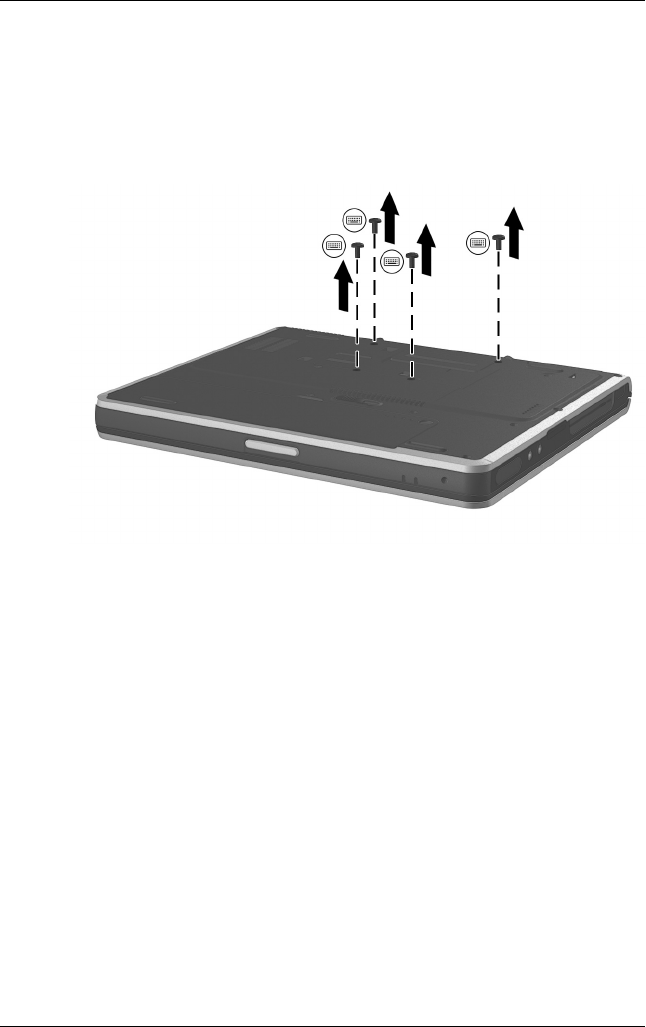
8–10 Hardware Guide
Hardware Upgrades
DRAFT - Revised: 10-28-02
Compaq CONFIDENTIAL—For Internal Use Only
11/13/02
File: SP-CH8-Hardware Upgrades.fm
4. Remove any battery packs from the notebook.
5. Remove the 4 keyboard screws from the bottom of the
notebook. A keyboard icon is located next to the keyboard
screws.
Removing the keyboard screws
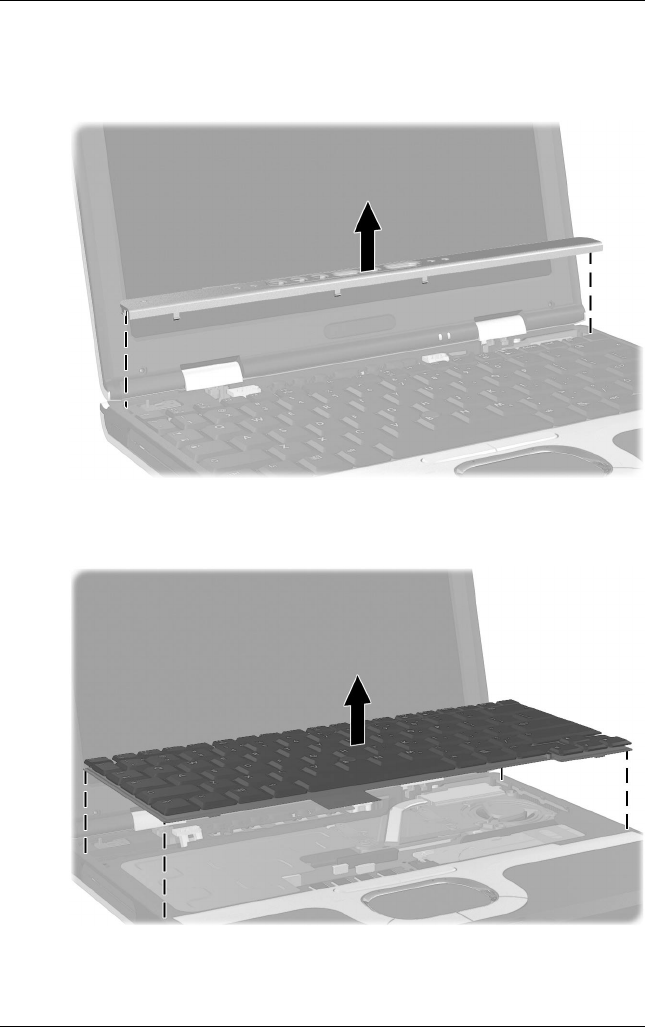
Hardware Upgrades
Hardware Guide 8–11
DRAFT - Revised: 10-28-02
Compaq CONFIDENTIAL—For Internal Use Only
11/13/02
File: SP-CH8-Hardware Upgrades.fm
6. Using a fingernail or small flat tool, remove the Quick
Launch button bezel located above the keyboard.
Removing the Easy Access button bezel
7. Remove the keyboard.
Removing the keyboard
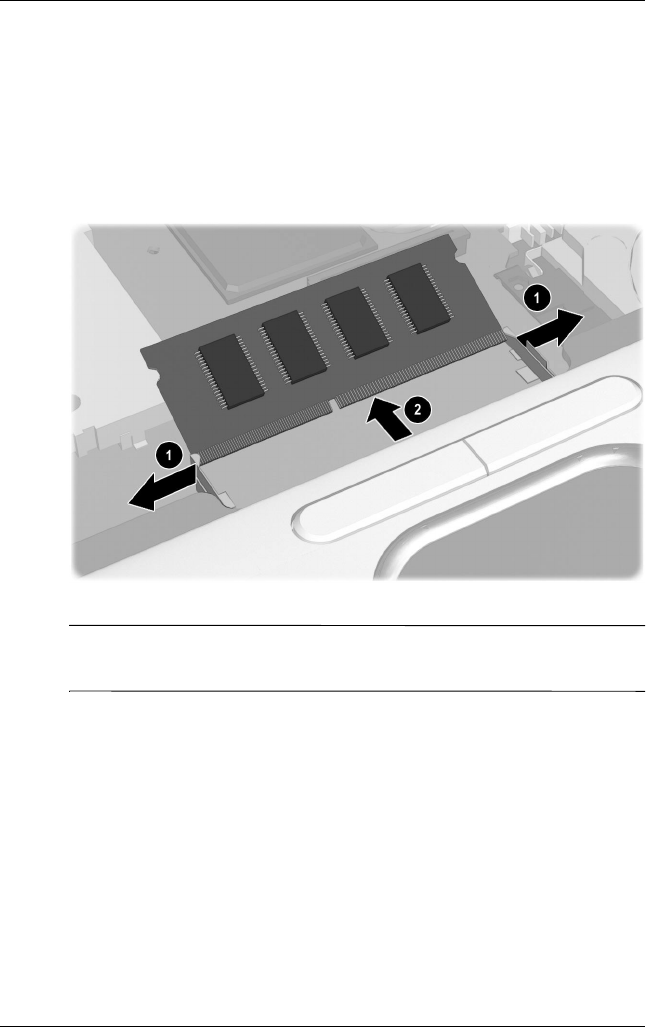
8–12 Hardware Guide
Hardware Upgrades
DRAFT - Revised: 10-28-02
Compaq CONFIDENTIAL—For Internal Use Only
11/13/02
File: SP-CH8-Hardware Upgrades.fm
8. Remove the existing memory board:
a. Pull away the retention clips on each side of the board 1.
(The board tilts upward.)
b. Lift the edge of the memory expansion board, then gently
pull it out of the slot 2.
Removing the existing memory board
✎To protect a memory board after it has been removed, place it in
an static-safe container.
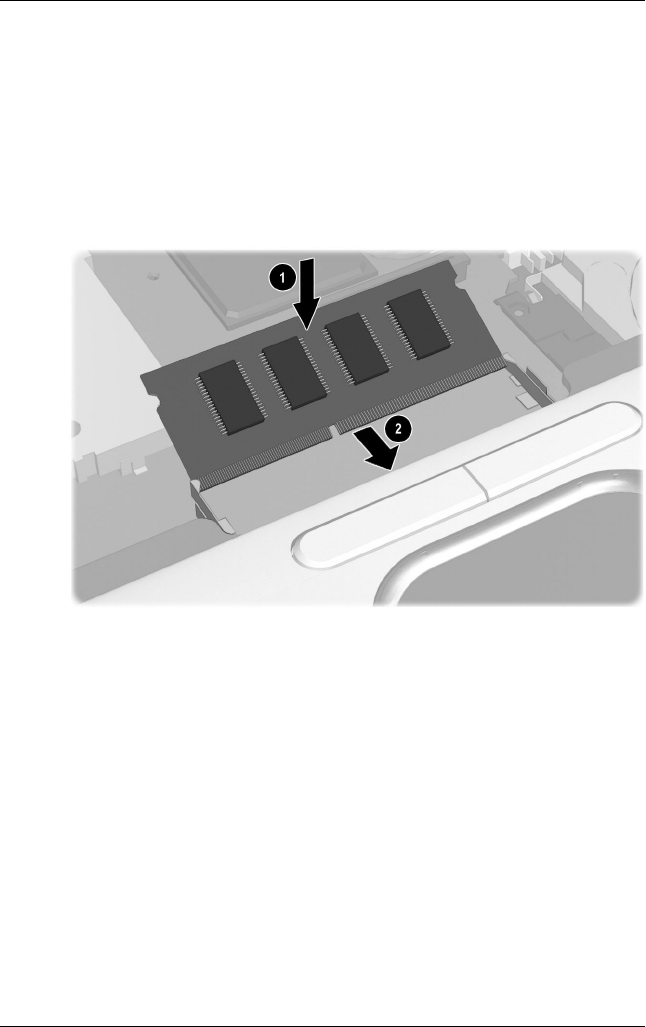
Hardware Upgrades
Hardware Guide 8–13
DRAFT - Revised: 10-28-02
Compaq CONFIDENTIAL—For Internal Use Only
11/13/02
File: SP-CH8-Hardware Upgrades.fm
9. Insert the upgraded memory board:
a. Align the keyed (notched) edge of the board with the
keyed area in the expansion slot 1.
b. Press the board into the slot from a 45-degree angle until
it is seated, then push the board downward until the
retention clips snap into place 2.
Inserting the upgraded memory board
10. Replace the keyboard.
11. Replace the Quick Launch button bezel.
12. Replace the keyboard screws located on the bottom of the
notebook.
13. Replace the battery packs.
14. Reconnect AC power and external devices.
15. Restart the notebook.

8–14 Hardware Guide
Hardware Upgrades
DRAFT - Revised: 10-28-02
Compaq CONFIDENTIAL—For Internal Use Only
11/13/02
File: SP-CH8-Hardware Upgrades.fm
Increasing RAM
You can increase the random access memory (RAM) of the
notebook with optional PC Cards or memory expansion boards.
When RAM increases, the operating system increases the hard
drive space reserved for the hibernation file.
If you experience problems with Hibernation after increasing
RAM, verify that your hard drive has enough free space for the
larger hibernation file.
■To display the amount of RAM in the system:
❏In Windows 2000 Professional, select Start > Settings
Control Panel > System > General tab.
❏In Windows XP, select Start > Control Panel >
Performance and Maintenance > System > General tab.
■To display the amount of free space on your hard drive:
Double-click the My Computer icon on the desktop, then
select your hard drive. Information about the space on the
drive is displayed in a status bar at the bottom of the window.
■To display the amount of space required by the
hibernation file:
❏In Windows 2000 Professional, select Start > Settings >
Control Panel > Compaq Power > Hibernation tab.
❏In Windows XP, select Start > Control Panel >
Performance and Maintenance > Power Options icon >
Hibernate tab.

DRAFT - Revised: 11-17-02
Hardware Guide A–1
Compaq CONFIDENTIAL—For Internal Use Only
11/13/02
File: SP-APPA-Specs.fm
A
Specifications
Notebook Dimensions
Operating Environment
Dimension Metric U.S.
Height 2.79 cm 1.1 in.
Width 27.94 cm 11 in.
Depth 23.37 cm 9.2 in.
Factor Metric U.S.
Temperature
Operating 10° to 35° C 50° to 95° F
Nonoperating –10° to 60° C 14° to 140° F
Relative humidity (noncondensing)
Operating 10 to 90% 10 to 90%
Nonoperating 5 to 95% 5 to 90%
Maximum altitude (unpressurized)
Operating 3,048 m 10,000 ft
Nonoperating 9,144 m 30,000 ft

A–2 Hardware Guide
Specifications
DRAFT - Revised: 11-17-02
Compaq CONFIDENTIAL—For Internal Use Only
11/13/02
File: SP-APPA-Specs.fm
Rated Input Power
Modem Specifications
Input Power Rating
Operating voltage 100–120/220–240 VAC RMS
Operating current 1.6/0.8 A RMS
Operating frequency range 50–60 Hz AC
When powered by a DC source 18.5V MAX
✎This product is designed for IT power systems in Norway
with phase-tophase voltage not exceeding 240 Vrms.
Factor Specification
Temperature
Operating 0° to 75° C (32° to 167° F)
Storage –40° to 75° C (–40° to 167° F)
Relative humidity (noncondensing)
Operating –10 to 90%
Nonoperating –5 to 95% @ 39° C (–5 to 95% @ 102° F)
Interfaces Communications
connector
Standard RJ-11
connector
Telephone, central
office network
Internal DAA
Power
Requirements
+3.3 volts ±5%, +5 volts ±5%

DRAFT - Revised: 11-17-02
Hardware Guide B–1
Compaq CONFIDENTIAL—For Internal Use Only
11/13/02
File: SP-APPB-Regulatory.fm
B
Regulatory Notices
This notebook has been tested and found to comply with limits
for a Class B digital device.
Regulatory Notices
For additional governmental agency information, refer on this CD
to Regulatory and Safety Notices.
Wireless Notices
In some situations or environments, the use of wireless devices
may be restricted by the proprietor of the building or responsible
representatives of the organization. Such restrictions may
apply when:
■Using the wireless equipment on airplanes, or
■The risk of interference to other devices or services is
perceived as harmful.
If you are uncertain of the policy that applies on the use of
wireless equipment in a specific organization or environment
(such as airports), you are encouraged to ask for authorization to
use this device prior to turning on the equipment.

B–2 Hardware Guide
Regulatory Notices
DRAFT - Revised: 11-17-02
Compaq CONFIDENTIAL—For Internal Use Only
11/13/02
File: SP-APPB-Regulatory.fm
ÅWARNING: Exposure to Radio Frequency Radiation
The radiated output power of this device is far below the FCC radio
frequency exposure limits. Nevertheless, the device should be used
in such a manner that the potential for human contact during
normal operation is minimized. In order to avoid the possibility of
exceeding the FCC radio frequency exposure limits, human
proximity to the antenna should not be less than 20 cm (8 inches)
during normal operation.
Electrostatic Discharge
A discharge of static electricity from fingers or other electrostatic
conductors may damage electronic components. Before handling
electrostatic-sensitive components, discharge static electricity.
For more information on electrostatic discharge, refer on this CD
to Regulatory and Safety Notices.

Index
Manual Title Variable Index–1
DRAFT - Revised: mm/dd/yy
Compaq CONFIDENTIAL—For Internal Use Only
11/13/02
File: 309971-001IX.fm
Index
A
AC Adapter 1–8
Aircraft Power Adapter
(optional) 1–8
airflow 1–6, 1–10
altitude specifications 9–1,
9–2
analog vs. digital telephone
lines 6–2
applications key 1–4
audio
adjusting volume 5–2
components 5–1
line-in jack 5–1, 5–3
line-out jack 5–2, 5–3
audio devices
microphone 5–2
microphone jack 1–5
speaker 1–5, 5–2
Automobile Power
Adapter/Charger (optional)
1–8
B
battery
low-battery condition 1–11
release latch 1–10
travel battery connector
1–10
battery bay
location 1–10
battery light 3–10
battery llight 1–11
battery packs
calibrating 3–16
charging 3–9
displaying charge
information 3–12
low-battery conditions
3–14
monitoring charge 3–11
primary, inserting 3–2
primary, removing 3–2,
3–3
Quick Check 3–13
travel (optional) 3–4
travel, inserting 3–4
travel, removing 3–5
type 3–1
bay
battery 1–10
hard drive 1–6, 4–2
buttons
Easy Access 1–3
Internet 2–10

Index–2 Manual Title Variable
Index
DRAFT - Revised: mm/dd/yy
Compaq CONFIDENTIAL—For Internal Use Only
11/13/02
File: 309971-001IX.fm
mute 2–11, 5–1, 5–2
PC Card, eject 1–5
pointing stick 1–2, 2–2
power/standby 1–3
Presentation Mode 2–10
TouchPad 1–2, 2–2
volume - 2–11, 5–1
volume + 2–11, 5–1
wireless 2–10
C
calibrating battery packs 3–16
Caps lock light 1–11
connector
docking 1–9
connectors
DC power 1–8
external monitor 1–8
travel battery 1–10
USB 1–8
contents of packing box 1–1
country-specific modem
adapter 6–4
D
DC power connector 1–8
digital vs. analog telephone
lines 6–1
display release latch 1–7
displaying battery pack charge
information 3–12
docking
connector 1–9
drives
caring for 4–1
hard drive activity light 4–2
inserting 4–6
removing 4–3
E
Easy Access buttons 5–2
functions 2–10
location 1–3
embedded numeric keypad
1–11
exhaust vent 1–6
expansion board 8–6
external devices (optional),
connecting 7–1
external monitor, connecting
7–1
external mouse 2–3
external MultiBay (optional)
7–4
F
features, notebook 1–2
Fn key 2–5
location 1–4
function keys 1–4
H
hard drive
activity light 1–11
bay 1–6
bezel 4–4, 4–7
caring for 4–1
displaying amount of free
space on 8–14
displaying amount of space
required by Hibernation
file 8–14
hard drive activity light 4–2
primary 4–2

Index
Manual Title Variable Index–3
DRAFT - Revised: mm/dd/yy
Compaq CONFIDENTIAL—For Internal Use Only
11/13/02
File: 309971-001IX.fm
removing 4–3
replacing 4–2, 4–6
retaining screw 4–3, 4–8
space on, required for
Hibernation file 8–14
viewing amount of free
space on 8–14
headphones, headset
(optional) 1–5
help and support 2–6
Hibernation
file, space requirements of
8–14
hotkey
quick reference 2–6
hotkeys
defined 2–5
hotkeys commands
adjusting screen brightness
2–8
initiate Standby 2–7
initiating quick controls
2–8
switching display and
image 2–7
system information 2–8
viewing battery charge
information 2–8
hubs, USB 7–2
humidity specifications 9–1,
9–2
I
infrared
capabilities 6–6
connection speeds 6–7
port 1–5
transmissions 6–7
using Standby with 6–8
Internet button 2–10
J
jack
audio line-out 1–5
audio-line in 1–5
S-video 1–8
jacks
audio line-in 5–1, 5–3
audio line-out 5–2
audio line-out jack 5–3
K
keyboard, external (optional)
entering hotkeys and
shortcut keys commands
from 2–9
keys
Microsoft logo 1–4
L
lights 1–11
battery 1–11, 3–10
caps lock 1–11
hard drive activity 1–11,
4–2
num lock 1–11
power/standby 1–11
scroll lock 1–11
wireless on/off 1–11
low-battery conditions 3–14
M
memory
displaying amount of 8–14

Index–4 Manual Title Variable
Index
DRAFT - Revised: mm/dd/yy
Compaq CONFIDENTIAL—For Internal Use Only
11/13/02
File: 309971-001IX.fm
expansion compartment
1–10
memory expansion board
8–6
slots, location 1–4
upgrading 8–6, 8–9
microphone 5–2
internal 1–7, 5–2
microphone jack 1–5, 5–1,
5–3
Microsoft logo key 1–4
mini PCI
compartment 1–10
wireless card 1–9
modem
cable 6–1, 6–3
connecting 6–1, 6–3
country-specific, adapter
6–4
monitor
external, connector 1–8
monitor, connecting external
7–1
Mouse Properties utility 2–4
mouse, external 2–3
MultiBay (optional) 7–4
mute button 2–11, 5–1, 5–2
N
network
cable 6–5
connecting to 6–6
noise suppression circuitry
6–2, 6–5
notebook features 1–2
Num lock light 1–11
numeric keypad, embedded
1–11
O
opening the notebook 1–7
operating environment
specfications 9–1, 9–2
P
PC Card
eject buttons 1–5
slots 1–5
PC Cards
inserting 8–2
removing 8–3
types 8–1
pointing devices
components 1–2, 2–2
external mouse 2–3
pointing stick 1–2, 2–1
preferences 2–4
TouchPad 1–2, 2–1
pointing stick
buttons 1–2, 2–2
location 1–2
using 2–2
port
infrared 1–5, 6–6
power
connector 1–8
conservation settings 3–20
conserving battery 3–19
power/standby
light 1–11
power/standby button 1–3
Presentation Mode button
2–10

Index
Manual Title Variable Index–5
DRAFT - Revised: mm/dd/yy
Compaq CONFIDENTIAL—For Internal Use Only
11/13/02
File: 309971-001IX.fm
projector, connecting 7–1
Q
Quick Check 3–13
R
RAM (random access
memory) 8–14
release latch 1–4
RJ-11 jack
connecting 6–1, 6–3
S
scroll lock key 2–9
Scroll lock light 1–11
SD cards
inserting 8–4
removing 8–5
security cable
connecting 7–5
slot 1–6
shortcut key
defined 2–5
quick reference 2–6
sleep button (Windows) 2–7
Sleep. See Standby
software
modem 3–19
SpeedStep (Windows 2000
Professional) 3–20
speaker 1–5, 5–2
SpeedStep (Windows 2000
Professional) 3–20
Standby
exiting 2–7
initiating 2–7
S-video 5–4
jack 1–8
T
temperature
operating 9–1, 9–2
TouchPad
buttons 1–2, 2–2
location 1–2
using 2–3
travel battery
attaching 3–6
battery packs 3–4
detaching 3–9
traveling with the notebook
operating environment
specifications 9–1, 9–2
U
USB
connecting 7–2
connectors 1–8
devices, using 7–3
enabling legacy support
7–3
external devices 7–2
hubs 7–2
mouse 2–3
utilities. See software
V
vents
intake 1–10
video
features 5–3
mode 5–5
volume
volume - button 2–11

Index–6 Manual Title Variable
Index
DRAFT - Revised: mm/dd/yy
Compaq CONFIDENTIAL—For Internal Use Only
11/13/02
File: 309971-001IX.fm
volume + button 2–11
volume - button 5–1
volume + button 5–1
volume, adjusting 5–2
W
wireless
antenna 1–7
button 2–10
infrared 6–6
infrared port 1–5
LAN 6–8
mini PCI compartment
1–10
on/off light 1–11